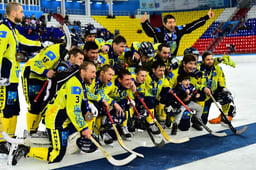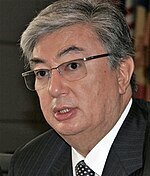Kazakhstan
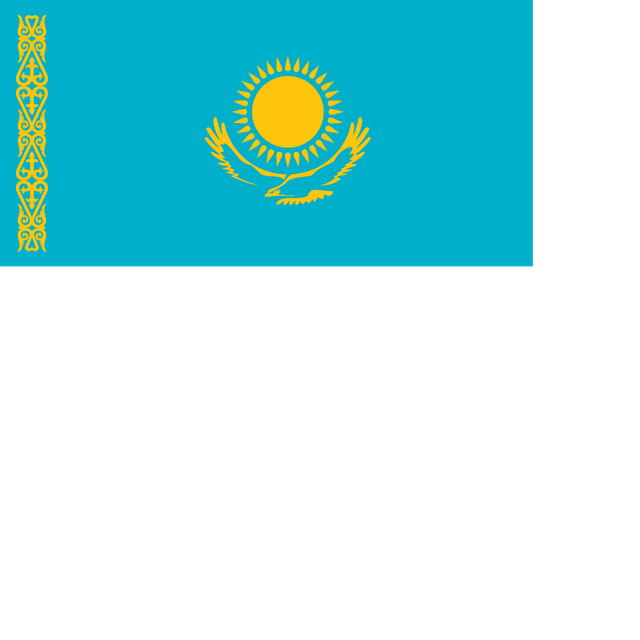
Kazakhstan

Republic of Kazakhstan
| |
|---|---|
**Anthem:**Менің Қазақстаным Meniń Qazaqstanym "My Kazakhstan" | |
 Location of Kazakhstan (green) | |
| Capital | Nur-Sultan 51°10′N 71°26′E [259] |
| Largest city | Almaty |
| Official languages | |
| Official scripts | Kazakh Latin alphabet, Kazakh Cyrillic alphabet (until 2025) |
| Ethnic groups (2018[4]) | |
| Religion |
|
| Demonym(s) | Kazakhstani[1][6] |
| Government | Unitary presidential constitutional republic |
• Chairman of the Security Council | Nursultan Nazarbayev |
• President | Kassym-Jomart Tokayev |
• Prime Minister | Askar Mamin |
• Chairman of the Senate | Dariga Nazarbayeva |
• Chairman of the Mazhilis | Nurlan Nigmatulin |
| Legislature | Parliament |
• Upper house | Senate |
• Lower house | Mazhilis |
| Formation | |
• Kazakh Khanate | 1465 |
• Alash Autonomy | 13 December 1917 |
• Kirghiz ASSR | 26 August 1920 |
• Kazakh ASSR | 19 June 1925 |
• Kazakh SSR | 5 December 1936 |
• Declared Sovereignty | 25 October 1990 |
• Reconstituted as the Republic of Kazakhstan | 10 December 1991 |
• Declared Independence from the USSR | 16 December 1991 |
• CIS Accession | 21 December 1991 |
| 26 December 1991 | |
• Admitted to the United Nations | 2 March 1992 |
• Current constitution | 30 August 1995 |
| Area | |
• Total | 2,724,900 km2(1,052,100 sq mi) (9th) |
• Water (%) | 1.7 |
| Population | |
• 2019 estimate | |
• Density | 7/km2(18.1/sq mi) (236th) |
| GDP(PPP) | 2019 estimate |
• Total | |
• Per capita | |
| GDP(nominal) | 2019 estimate |
• Total | |
• Per capita | |
| Gini(2017) | low |
| HDI(2017) | very high · 58th |
| Currency | Tenge (₸) (KZT) |
| Time zone | UTC+5 / +6(West / East) |
| Driving side | right |
| Calling code | +7-6xx, +7-7xx |
| ISO 3166 code | KZ |
| Internet TLD |
|
Kazakhstan[2] (Kazakh: Қазақстан, romanized: Qazaqstan, IPA: [qɑzɑqˈstɑn] (listen); Russian: Казахстан, romanized: Kazakhstan), officially the Republic of Kazakhstan (Kazakh: Қазақстан Республикасы, romanized: Qazaqstan Respýblıkasy; Russian: Республика Казахстан, tr. Respublika Kazakhstan),[6][15] is the world's largest landlocked country, and the ninth largest in the world, with an area of 2,724,900 square kilometres (1,052,100 sq mi).[6][16] It is a transcontinental country largely located in Asia; the most western parts are in Europe. Kazakhstan is the dominant nation of Central Asia economically, generating 60% of the region's GDP, primarily through its oil and gas industry. It also has vast mineral resources.[17]
Kazakhstan is officially a democratic, secular, unitary, constitutional republic with a diverse cultural heritage.[18] Kazakhstan shares borders with Russia, China, Kyrgyzstan, Uzbekistan, and Turkmenistan, and also adjoins a large part of the Caspian Sea. The terrain of Kazakhstan includes flatlands, steppe, taiga, rock canyons, hills, deltas, snow-capped mountains, and deserts. Kazakhstan has an estimated 18.3 million people as of 2018.[19] Given its large land area, its population density is among the lowest, at less than 6 people per square kilometre (15 people per sq mi). The capital is Nur-Sultan (until 2019 Astana), where it was moved in 1997 from Almaty, the country's largest city.
The territory of Kazakhstan has historically been inhabited by nomadic groups and empires. In antiquity, the nomadic Scythians have inhabited the land and the Persian Achaemenid Empire expanded towards the southern territory of the modern country. Turkic nomads who trace their ancestry to many Turkic states such as Turkic Khaganate etc. have inhabited the country throughout the country's history. In the 13th century, the territory joined the Mongolian Empire under Genghis Khan. By the 16th century, the Kazakh emerged as a distinct group, divided into three jüz (ancestor branches occupying specific territories). The Russians began advancing into the Kazakh steppe in the 18th century, and by the mid-19th century, they nominally ruled all of Kazakhstan as part of the Russian Empire. Following the 1917 Russian Revolution, and subsequent civil war, the territory of Kazakhstan was reorganised several times. In 1936, it was made the Kazakh Soviet Socialist Republic, part of the Soviet Union.
Kazakhstan was the last of the Soviet republics to declare independence during the dissolution of the Soviet Union in 1991. Nursultan Nazarbayev, the first President of Kazakhstan, was characterized as an authoritarian, and his government was accused of numerous human rights violations, including suppression of dissent and censorship of the media. Nazarbayev resigned in March 2019, with Senate Chairman Kassym-Jomart Tokayev taking office as Interim President.[17] Kazakhstan has worked to develop its economy, especially its dominant hydrocarbon industry.[17] Human Rights Watch says that "Kazakhstan heavily restricts freedom of assembly, speech, and religion",[20] and other human rights organisations regularly describe Kazakhstan's human rights situation as poor.
Kazakhstan's 131 ethnicities include Kazakhs (63% of the population), Russians, Uzbeks, Ukrainians, Germans, Tatars, and Uyghurs.[21] Islam is the religion of about 70% of the population, with Christianity practised by 26%.[22] Kazakhstan officially allows freedom of religion, but religious leaders who oppose the government are suppressed.[23] The Kazakh language is the state language, and Russian has equal official status for all levels of administrative and institutional purposes.[6][24]
Republic of Kazakhstan
| |
|---|---|
**Anthem:**Менің Қазақстаным Meniń Qazaqstanym "My Kazakhstan" | |
 Location of Kazakhstan (green) | |
| Capital | Nur-Sultan 51°10′N 71°26′E [259] |
| Largest city | Almaty |
| Official languages | |
| Official scripts | Kazakh Latin alphabet, Kazakh Cyrillic alphabet (until 2025) |
| Ethnic groups (2018[4]) | |
| Religion |
|
| Demonym(s) | Kazakhstani[1][6] |
| Government | Unitary presidential constitutional republic |
• Chairman of the Security Council | Nursultan Nazarbayev |
• President | Kassym-Jomart Tokayev |
• Prime Minister | Askar Mamin |
• Chairman of the Senate | Dariga Nazarbayeva |
• Chairman of the Mazhilis | Nurlan Nigmatulin |
| Legislature | Parliament |
• Upper house | Senate |
• Lower house | Mazhilis |
| Formation | |
• Kazakh Khanate | 1465 |
• Alash Autonomy | 13 December 1917 |
• Kirghiz ASSR | 26 August 1920 |
• Kazakh ASSR | 19 June 1925 |
• Kazakh SSR | 5 December 1936 |
• Declared Sovereignty | 25 October 1990 |
• Reconstituted as the Republic of Kazakhstan | 10 December 1991 |
• Declared Independence from the USSR | 16 December 1991 |
• CIS Accession | 21 December 1991 |
| 26 December 1991 | |
• Admitted to the United Nations | 2 March 1992 |
• Current constitution | 30 August 1995 |
| Area | |
• Total | 2,724,900 km2(1,052,100 sq mi) (9th) |
• Water (%) | 1.7 |
| Population | |
• 2019 estimate | |
• Density | 7/km2(18.1/sq mi) (236th) |
| GDP(PPP) | 2019 estimate |
• Total | |
• Per capita | |
| GDP(nominal) | 2019 estimate |
• Total | |
• Per capita | |
| Gini(2017) | low |
| HDI(2017) | very high · 58th |
| Currency | Tenge (₸) (KZT) |
| Time zone | UTC+5 / +6(West / East) |
| Driving side | right |
| Calling code | +7-6xx, +7-7xx |
| ISO 3166 code | KZ |
| Internet TLD |
|
Etymology
Though traditionally referring only to ethnic Kazakhs, including those living in China, Russia, Turkey, Uzbekistan and other neighbouring countries, the term "Kazakh" is increasingly being used to refer to any inhabitant of Kazakhstan, including non-Kazakhs.[26]
History
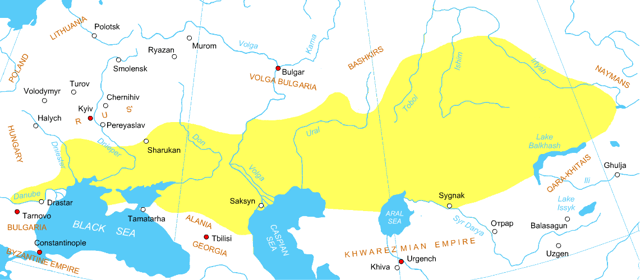
Cuman–Kipchak confederation in Eurasia circa 1200. The Kazakhs are descendants of Kipchaks, Nogais and other Turkic and medieval Mongol tribes.
Kazakhstan has been inhabited since the Paleolithic.[27] Pastoralism developed during the Neolithic as the region's climate and terrain are best suited for a nomadic lifestyle. The Kazakh territory was a key constituent of the Eurasian Steppe route, the ancestor of the terrestrial Silk Roads. Archaeologists believe that humans first domesticated the horse (i.e. ponies) in the region's vast steppes. During recent prehistoric times Central Asia was inhabited by groups like the possibly Proto-Indo-European Afanasievo culture,[28] later early Indo-Iranians cultures such as Andronovo,[29] and later Indo-Iranians such as the Saka and Massagetae.[30][31] Other groups included the nomadic Scythians and the Persian Achaemenid Empire in the southern territory of the modern country. In 329 BC, Alexander the Great and his Macedonian army fought in the Battle of Jaxartes against the Scythians along the Jaxartes River, now known as the Syr Darya along the southern border of modern Kazakhstan.
Kazakh Khanate

Ablai Khan, khan of the Middle jüz from 1771 to 1781
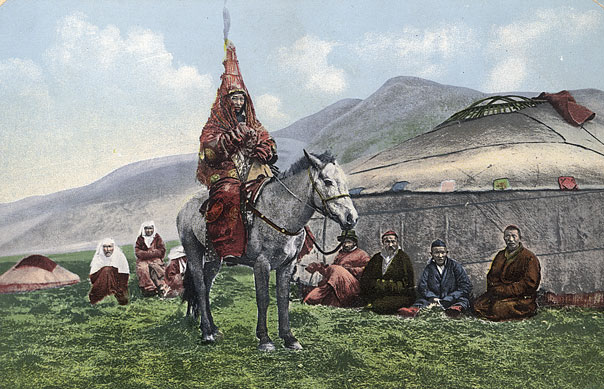
Traditional Kazakh wedding dress
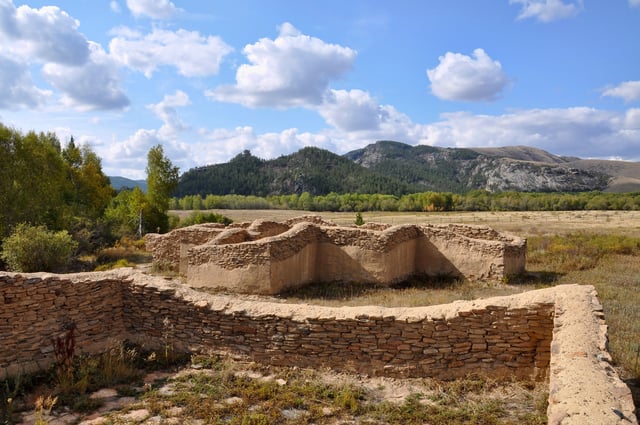
Kyzyl Kensh Palace Ruins in Karkaraly National Park.

Approximate areas occupied by the three Kazakh jüz in the early 20th century. Junior juz Middle juz Great juz
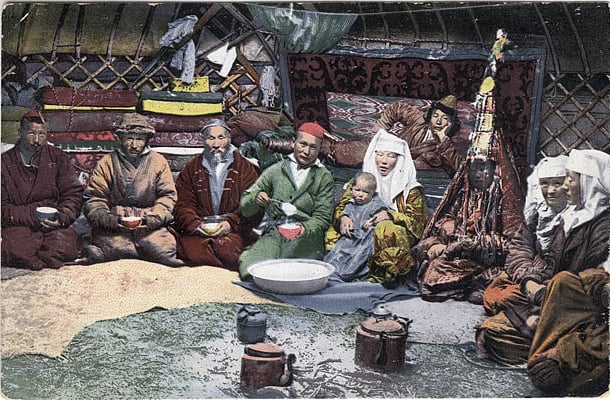
Kazakh family inside a Yurt, 1911/1914
The Cuman entered the steppes of modern-day Kazakhstan around the early 11th century, where they later joined with the Kipchak and established the vast Cuman-Kipchak confederation. While ancient cities Taraz (Aulie-Ata) and Hazrat-e Turkestan had long served as important way-stations along the Silk Road connecting Asia and Europe, true political consolidation began only with the Mongol rule of the early 13th century. Under the Mongol Empire, the largest in world history, administrative districts were established. These eventually came under the rule of the emergent Kazakh Khanate (Kazakhstan).
Throughout this period, traditional nomadic life and a livestock-based economy continued to dominate the steppe. In the 15th century, a distinct Kazakh identity began to emerge among the Turkic tribes, a process which was consolidated by the mid-16th century with the appearance of the Kazakh language, culture, and economy.
Nevertheless, the region was the focus of ever-increasing disputes between the native Kazakh emirs and the neighbouring Persian-speaking peoples to the south. At its height, the Khanate would rule parts of Central Asia and control Cumania. By the early 17th century, the Kazakh Khanate was struggling with the impact of tribal rivalries, which had effectively divided the population into the Great, Middle and Little (or Small) hordes (jüz). Political disunion, tribal rivalries, and the diminishing importance of overland trade routes between east and west weakened the Kazakh Khanate. Khiva Khanate used this opportunity and annexed Mangyshlak Peninsula. Uzbek rule there lasted two centuries until the Russian arrival.
During the 17th century, the Kazakhs fought Oirats, a federation of western Mongol tribes, including the Dzungar.[32] The beginning of the 18th century marked the zenith of the Kazakh Khanate. During this period the Little Horde participated in the 1723–1730 war against the Dzungar Khanate, following their "Great Disaster" invasion of Kazakh territories. Under the leadership of Abul Khair Khan, the Kazakh won major victories over the Dzungar at the Bulanty River in 1726, and at the Battle of Anrakay in 1729.[33]
Ablai Khan participated in the most significant battles against the Dzungar from the 1720s to the 1750s, for which he was declared a "batyr" ("hero") by the people. The Kazakh suffered from the frequent raids against them by the Volga Kalmyk. The Kokand Khanate used the weakness of Kazakh jüzs after Dzungar and Kalmyk raids and conquered present Southeastern Kazakhstan, including Almaty, the formal capital in the first quarter of the 19th century. Also, the Emirate of Bukhara ruled Shymkent before the Russians took dominance.
Russian Empire
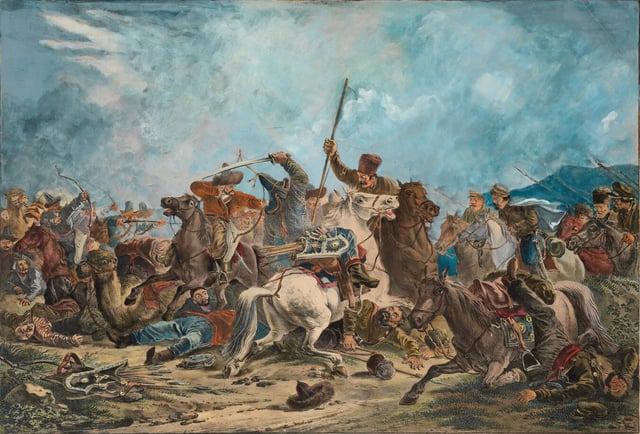
Ural Cossacks skirmish with Kazakhs (the Russians originally called the Kazakhs “Kirgiz”)

Alikhan Bukeikhanov, a Kazakh statesman who served as the Prime Minister of the Alash Autonomy from 1917 to 1920.
In the first half of the 18th century the Russian Empire constructed the Irtysh line, a series of forty-six forts and ninety-six redoubts, including Omsk (1716), Semipalatinsk (1718), Pavlodar (1720), Orenburg (1743) and Petropavlovsk (1752),[34] to prevent Kazakh and Oirat raids into Russian territory.[35] In the late 18th century the Kazakhs took advantage of Pugachev's rebellion, which was centred on the Volga area, to raid Russian and Volga German settlements.[36] In the 19th century, the Russian Empire began to expand its influence into Central Asia. The "Great Game" period is generally regarded as running from approximately 1813 to the Anglo-Russian Convention of 1907. The tsars effectively ruled over most of the territory belonging to what is now the Republic of Kazakhstan.
The Russian Empire introduced a system of administration and built military garrisons and barracks in its effort to establish a presence in Central Asia in the so-called "Great Game" for dominance in the area against the British Empire, which was extending its influence from the south in India and Southeast Asia. Russia built its first outpost, Orsk, in 1735. Russia introduced the Russian language in all schools and governmental organisations.
Russian efforts to impose its system aroused the resentment by the Kazakh people, and, by the 1860s, some Kazakhs resisted Russia's rule. It had disrupted the traditional nomadic lifestyle and livestock-based economy, and people were suffering from hunger and starvation, with some Kazakh tribes being decimated. The Kazakh national movement, which began in the late 19th century, sought to preserve the native language and identity by resisting the attempts of the Russian Empire to assimilate and stifle them.
From the 1890s onward, ever-larger numbers of settlers from the Russian Empire began colonising the territory of present-day Kazakhstan, in particular, the province of Semirechye. The number of settlers rose still further once the Trans-Aral Railway from Orenburg to Tashkent was completed in 1906. A specially created Migration Department (Переселенческое Управление) in St. Petersburg oversaw and encouraged the migration to expand Russian influence in the area. During the 19th century about 400,000 Russians immigrated to Kazakhstan, and about one million Slavs, Germans, Jews, and others immigrated to the region during the first third of the 20th century.[37] Vasile Balabanov was the administrator responsible for the resettlement during much of this time.
The competition for land and water that ensued between the Kazakh and the newcomers caused great resentment against colonial rule during the final years of the Russian Empire. The most serious uprising, the Central Asian Revolt, occurred in 1916. The Kazakh attacked Russian and Cossack settlers and military garrisons. The revolt resulted in a series of clashes and in brutal massacres committed by both sides.[38] Both sides resisted the communist government until late 1919.
Soviet Union

Stanitsa Sofiiskaya, Talgar. 1920s
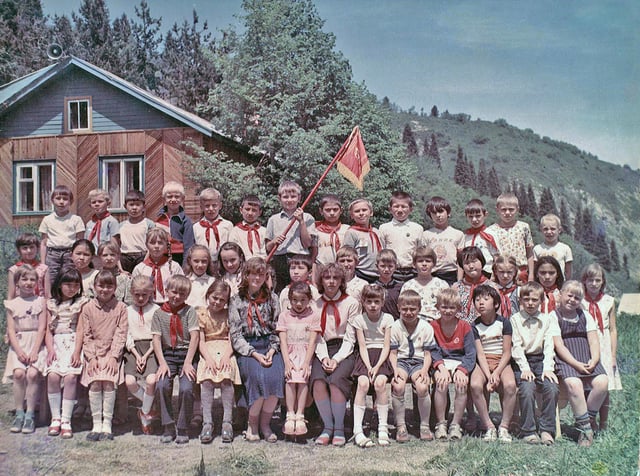
Young Pioneers at a Young Pioneer camp in Kazakh SSR

The International Conference on Primary Health Care in 1978, known as the Alma-Ata Declaration.
Following the collapse of central government in Petrograd in November 1917, the Kazakhs (then in Russia officially referred to as "Kirghiz") experienced a brief period of autonomy (the Alash Autonomy) to eventually succumb to the Bolsheviks′ rule. On 26 August 1920, the Kirghiz Autonomous Socialist Soviet Republic within the Russian Soviet Federative Socialist Republic (RSFSR) was established. The Kirghiz ASSR included the territory of present-day Kazakhstan, but its administrative centre was a mainly Russian-populated town of Orenburg. In June 1925, the Kirghiz ASSR was renamed the Kazak ASSR and its administrative centre was transferred to the town of Kyzylorda, and in April 1927 to Alma-Ata.
Soviet repression of the traditional elite, along with forced collectivisation in the late 1920s and 1930s, brought famine and high fatalities, leading to unrest (see also: Famine in Kazakhstan of 1932–33).[39][40] During the 1930s, some members of the Kazakh cultured society were executed — as part of the policies of political reprisals pursued by the Soviet government in Moscow.
On 5 December 1936, the Kazakh Autonomous Soviet Socialist Republic (whose territory by then corresponded to that of modern Kazakhstan) was detached from the Russian Soviet Federative Socialist Republic (RSFSR) and made the Kazakh Soviet Socialist Republic, a full union republic of the USSR, one of eleven such republics at the time, along with the Kirghiz Soviet Socialist Republic.
The republic was one of the destinations for exiled and convicted persons, as well as for mass resettlements, or deportations affected by the central USSR authorities during the 1930s and 1940s, such as approximately 400,000 Volga Germans deported from the Volga German Autonomous Soviet Socialist Republic in September–October 1941, and then later the Greeks and Crimean Tatars. Deportees and prisoners were interned in some of the biggest Soviet labour camps (the Gulag), including ALZhIR camp outside Astana, which was reserved for the wives of men considered "enemies of the people".[41] Many moved due to the policy of population transfer in the Soviet Union and others were forced into involuntary settlements in the Soviet Union.
The Soviet-German War (1941–1945) led to an increase in industrialisation and mineral extraction in support of the war effort. At the time of the USSR's leader Joseph Stalin's death in 1953, however, Kazakhstan still had an overwhelmingly agricultural economy. In 1953, Soviet leader Nikita Khrushchev initiated the Virgin Lands Campaign designed to turn the traditional pasturelands of Kazakhstan into a major grain-producing region for the Soviet Union. The Virgin Lands policy brought mixed results. However, along with later modernisations under Soviet leader Leonid Brezhnev (in power 1964–1982), it accelerated the development of the agricultural sector, which remains the source of livelihood for a large percentage of Kazakhstan's population. Because of the decades of privation, war and resettlement, by 1959 the Kazakh had become a minority in the country, making up 30% of the population. Ethnic Russians accounted for 43%.[42]
In 1947, the USSR government, as part of its atomic bomb project, founded an atomic bomb test site near the north-eastern town of Semipalatinsk, where the first Soviet nuclear bomb test was conducted in 1949. Hundreds of nuclear tests were conducted until 1989 and had negative ecological and biological consequences.[43] The Anti-nuclear movement in Kazakhstan became a major political force in the late 1980s.
In December 1986, mass demonstrations by young ethnic Kazakhs, later called the Jeltoqsan riot, took place in Almaty to protest the replacement of the First Secretary of the Communist Party of the Kazakh SSR Dinmukhamed Konayev with Gennady Kolbin from the Russian SFSR. Governmental troops suppressed the unrest, several people were killed, and many demonstrators were jailed. In the waning days of Soviet rule, discontent continued to grow and found expression under Soviet leader Mikhail Gorbachev's policy of glasnost.
Independence

The Monument of Independence, Republic Square, Almaty.
On 25 October 1990, Kazakhstan declared its sovereignty on its territory as a republic within the Soviet Union. Following the August 1991 aborted coup attempt in Moscow, Kazakhstan declared independence on 16 December 1991, thus becoming the last Soviet republic to declare independence. Ten days later, the Soviet Union itself ceased to exist.
Kazakhstan's communist-era leader, Nursultan Nazarbayev, became the country's first President. Nazarbayev ruled in an authoritarian manner, which some believed was needed in the first years of independence. Emphasis was on converting the country's economy to a market economy while political reforms lagged behind achievements in the economy. By 2006, Kazakhstan generated 60% of the GDP of Central Asia, primarily through its oil industry.[17]
In 1997, the government moved the capital to Astana, (Astana was renamed Nur-Sultan on 23 March 2019), from Almaty, Kazakhstan's largest city, where it had been established under the Soviet Union.
Geography
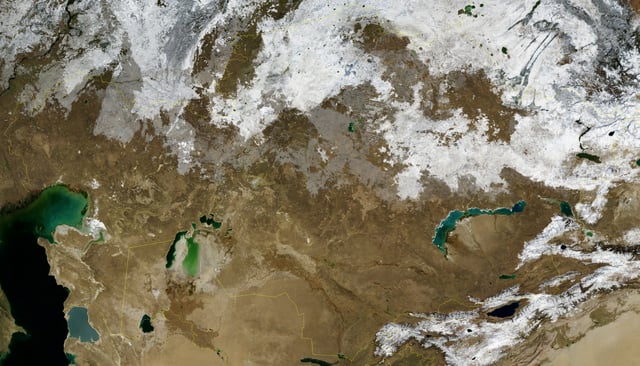
Satellite image of Kazakhstan in November 2004.
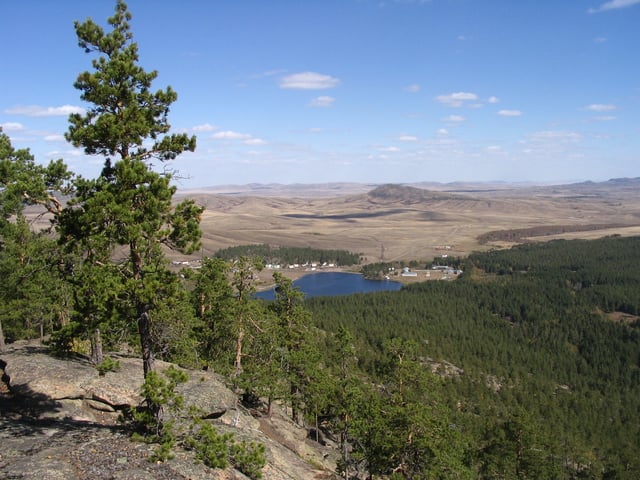
Karaganda Region

Kazakh steppe in the Akmola Region
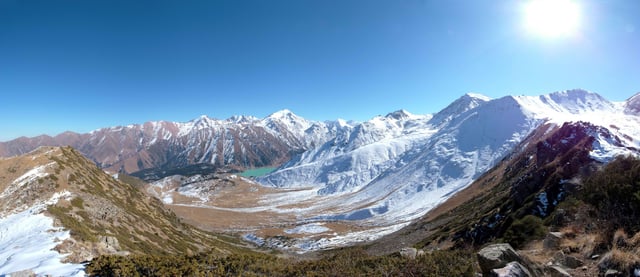
The mountainous region of the Tian Shan in south-eastern Kazakhstan
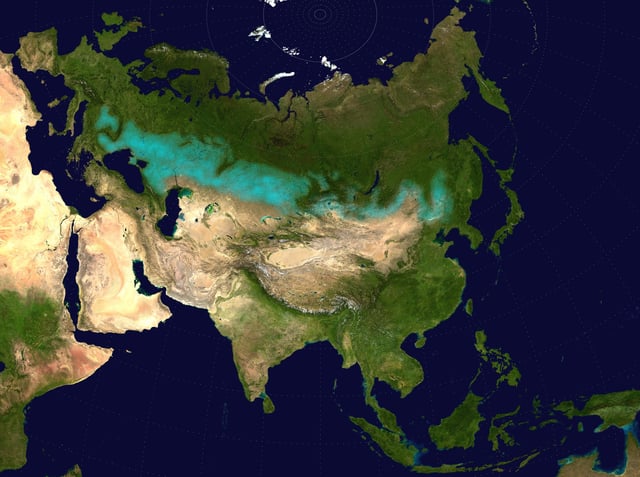
The Kazakh Steppe of part of the Eurasian Steppe Belt (in on the map).
As it extends across both sides of the Ural River, considered the dividing line with the European continent, Kazakhstan is one of only two landlocked countries in the world that has territory in two continents (the other is Azerbaijan).
With an area of 2,700,000 square kilometres (1,000,000 sq mi) – equivalent in size to Western Europe – Kazakhstan is the ninth-largest country and largest landlocked country in the world. While it was part of the Soviet Union, Kazakhstan lost some of its territory to China's Xinjiang autonomous region[44] and some to Uzbekistan's Karakalpakstan autonomous republic.
It shares borders of 6,846 kilometres (4,254 mi) with Russia, 2,203 kilometres (1,369 mi) with Uzbekistan, 1,533 kilometres (953 mi) with China, 1,051 kilometres (653 mi) with Kyrgyzstan, and 379 kilometres (235 mi) with Turkmenistan. Major cities include Nur-Sultan, Almaty, Karagandy, Shymkent, Atyrau, and Oskemen. It lies between latitudes 40° and 56° N, and longitudes 46° and 88° E. While located primarily in Asia, a small portion of Kazakhstan is also located west of the Urals in Eastern Europe.[45]
Kazakhstan's terrain extends west to east from the Caspian Sea to the Altay Mountains and north to south from the plains of Western Siberia to the oases and deserts of Central Asia. The Kazakh Steppe (plain), with an area of around 804,500 square kilometres (310,600 sq mi), occupies one-third of the country and is the world's largest dry steppe region. The steppe is characterised by large areas of grasslands and sandy regions. Major seas, lakes and rivers include the Aral Sea, Lake Balkhash and Lake Zaysan, the Charyn River and gorge and the Ili, Irtysh, Ishim, Ural and Syr Darya rivers.
The Charyn Canyon is 80 kilometres (50 mi) long, cutting through a red sandstone plateau and stretching along the Charyn River gorge in northern Tian Shan ("Heavenly Mountains", 200 km (124 mi) east of Almaty) at 43°21′1.16″N 79°4′49.28″E [260] . The steep canyon slopes, columns and arches rise to heights of between 150 and 300 metres (490 and 980 feet). The inaccessibility of the canyon provided a safe haven for a rare ash tree, Fraxinus sogdiana, that survived the Ice Age and is now also grown in some other areas. Bigach crater, at 48°30′N 82°00′E [261] , is a Pliocene or Miocene asteroid impact crater, 8 km (5 mi) in diameter and estimated to be 5±3 million years old.
Natural resources
Kazakhstan has an abundant supply of accessible mineral and fossil fuel resources. Development of petroleum, natural gas, and mineral extractions has attracted most of the over $40 billion in foreign investment in Kazakhstan since 1993 and accounts for some 57% of the nation's industrial output (or approximately 13% of gross domestic product). According to some estimates,[46] Kazakhstan has the second largest uranium, chromium, lead, and zinc reserves; the third largest manganese reserves; the fifth largest copper reserves; and ranks in the top ten for coal, iron, and gold. It is also an exporter of diamonds. Perhaps most significant for economic development, Kazakhstan also currently has the 11th largest proven reserves of both petroleum and natural gas.[47]
In total, there are 160 deposits with over 2.7 billion tonnes (2.7 billion long tons) of petroleum. Oil explorations have shown that the deposits on the Caspian shore are only a small part of a much larger deposit. It is said that 3.5 billion tonnes (3.4 billion long tons) of oil and 2.5 billion cubic metres (88 billion cubic feet) of gas could be found in that area. Overall the estimate of Kazakhstan's oil deposits is 6.1 billion tonnes (6.0 billion long tons). However, there are only three refineries within the country, situated in Atyrau,[48] Pavlodar, and Shymkent. These are not capable of processing the total crude output, so much of it is exported to Russia. According to the US Energy Information Administration Kazakhstan was producing approximately 1,540,000 barrels (245,000 m3) of oil per day in 2009.[49]
On 17 October 2013, the Extractive Industries Transparency Initiative (EITI) accepted Kazakhstan as "EITI Compliant", meaning that the country has a basic and functional process to ensure the regular disclosure of natural resource revenues.[52]
Climate

Kazakhstan map of Köppen climate classification.
Kazakhstan has an "extreme" continental climate, with warm summers and very cold winters. Indeed, Nursultan is the second coldest capital city in the world after Ulaanbaatar. Precipitation varies between arid and semi-arid conditions, the winter being particularly dry.[53]
| Location | July (°C) | July (°F) | January (°C) | January (°F) |
|---|---|---|---|---|
| Almaty | 30/18 | 86/64 | 0/−8 | 33/17 |
| Shymkent | 32/17 | 91/66 | 4/−4 | 39/23 |
| Karaganda | 27/14 | 80/57 | −8/−17 | 16/1 |
| Nur-Sultan | 27/15 | 80/59 | −10/−18 | 14/−1 |
| Pavlodar | 28/15 | 82/59 | −11/−20 | 12/−5 |
| Aktobe | 30/15 | 86/61 | −8/−16 | 17/2 |
Wildlife
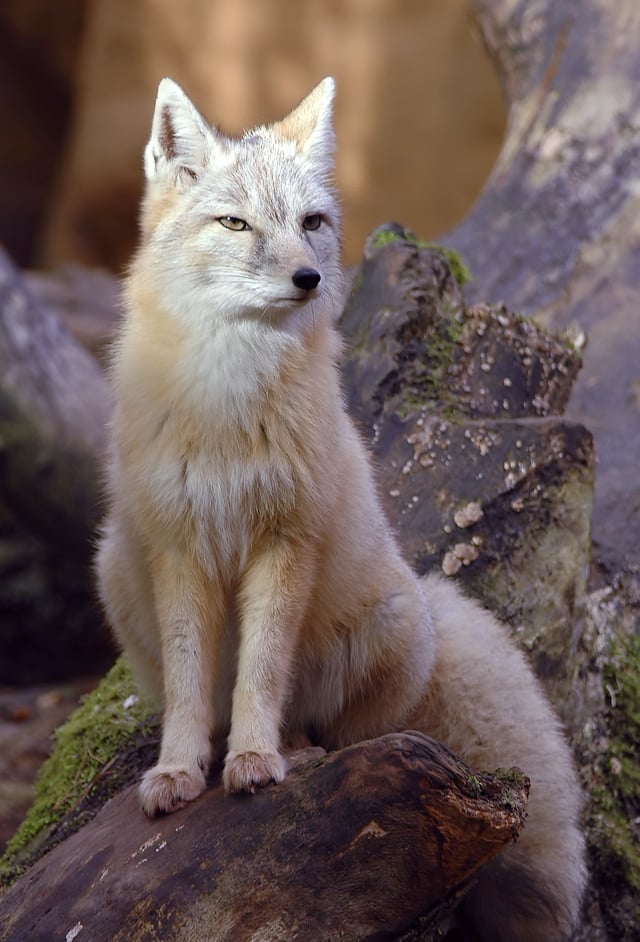
Corsac fox
There are ten nature reserves and ten national parks in Kazakhstan that provide safe haven for many rare and endangered plants and animals. Common plants are Astragalus, Gagea, Allium, Carex and Oxytropis; endangered plant species include native wild apple (Malus sieversii), wild grape (Vitis vinifera) and several wild tulip species (e.g. Tulipa greigii) and rare onion species Allium karataviense, also Iris willmottiana and Tulipa kaufmanniana.[55][56]
Common mammals include the wolf, red fox, corsac fox, moose, argali (the largest species of sheep), Eurasian lynx, Pallas's cat, and snow leopards, several of which are protected. Kazakhstan's Red Book of Protected Species lists 125 vertebrates including many birds and mammals, and 404 plants including fungi, algae and lichen.[57]
Politics
Political system
Kazakhstan is a democratic, secular, constitutional unitary republic; Nursultan Nazarbayev led the country from 1991 to 2019.[58][59] He was succeeded by Kassym-Jomart Tokayev.[60][61] The President may veto legislation that has been passed by the Parliament and is also the commander in chief of the armed forces. The Prime Minister chairs the Cabinet of Ministers and serves as Kazakhstan's head of government. There are three deputy prime ministers and sixteen ministers in the Cabinet.
Kazakhstan has a bicameral Parliament composed of the Majilis (the lower house) and Senate (the upper house).[62] Single-mandate districts popularly elect 107 seats in the Majilis; there also are ten members elected by party-list vote. The Senate has 47 members. Two senators are selected by each of the elected assemblies (Maslikhats) of Kazakhstan's sixteen principal administrative divisions (fourteen regions plus the cities of Nur-Sultan and Almaty). The President appoints the remaining seven senators. Majilis deputies and the government both have the right of legislative initiative, though the government proposes most legislation considered by the Parliament.
Elections

Ak Orda Presidential Palace.

Parliament of Kazakhstan
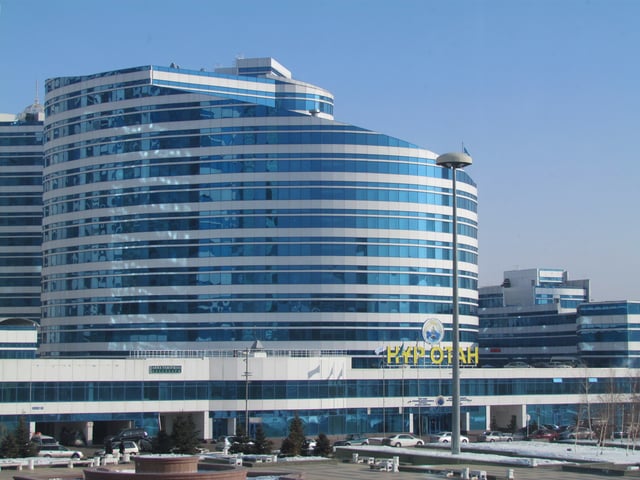
Nur Otan Headquarters in Nur-Sultan
Elections to the Majilis in September 2004, yielded a lower house dominated by the pro-government Otan Party, headed by President Nazarbayev. Two other parties considered sympathetic to the president, including the agrarian-industrial bloc AIST and the Asar Party, founded by President Nazarbayev's daughter, won most of the remaining seats. Opposition parties, which were officially registered and competed in the elections, won a single seat during elections. The Organization for Security and Cooperation in Europe was monitoring the election, which it said fell short of international standards.
On 4 December 2005, Nursultan Nazarbayev was re-elected in an apparent landslide victory. The electoral commission announced that he had won over 90% of the vote. The Organization for Security and Cooperation in Europe (OSCE) concluded the election did not meet international standards despite some improvements in the administration of the election.[63]
On 17 August 2007, elections to the lower house of parliament were held and a coalition led by the ruling Nur-Otan Party, which included the Asar Party, the Civil Party of Kazakhstan, and the Agrarian Party, won every seat with 88% of the vote. None of the opposition parties has reached the benchmark 7% level of the seats. Opposition parties made accusations of serious irregularities in the election.[64][65]
In 2010, President Nazarbayev rejected a call from supporters to hold a referendum to keep him in office until 2020. He insisted on presidential elections for a five-year term. In a vote held on 3 April 2011, President Nazarbayev received 95.54% of the vote with 89.9% of registered voters participating.[66] In March 2011, Nazarbayev outlined the progress made toward democracy by Kazakhstan.[67] As of 2010, Kazakhstan was reported on the Democracy Index by The Economist as an authoritarian regime.
Administrative divisions
Kazakhstan is divided into fourteen regions (Kazakh: облыстар, oblystar; Russian: области, oblasti). The regions are subdivided into 177 districts (Kazakh: аудандар, aýdandar; Russian: районы, rayony).[73] The districts are further subdivided into rural districts at the lowest level of administration, which include all rural settlements and villages without an associated municipal government.[74]
The cities of Almaty and Nur-Sultan have status "state importance" and do not belong to any region. The city of Baikonur has a special status because it is being leased until 2050 to Russia for the Baikonur cosmodrome.[6] In June 2018 the city of Shymkent became a "city of republican significance".[75]
Each region is headed by an akim (regional governor) appointed by the president. District akims [akimi?] are appointed by regional akims. Kazakhstan's government relocated its capital from Almaty, established under the Soviet Union, to Astana on 10 December 1997.
Municipal divisions
Municipalities exist at each level of administrative division in Kazakhstan. Cities of republican, regional, and district significance are designated as urban inhabited localities; all others are designated rural.[74] At the highest level are the cities of Almaty and Nur-Sultan, which are classified as cities of republican significance on the administrative level equal to that of a region.[73] At the intermediate level are cities of regional significance on the administrative level equal to that of a district. Cities of these two levels may be divided into city districts.[73] At the lowest level are cities of district significance, and over two-thousand villages and rural settlements (aul) on the administrative level equal to that of rural districts.[73][76]
Urban centres
Foreign relations
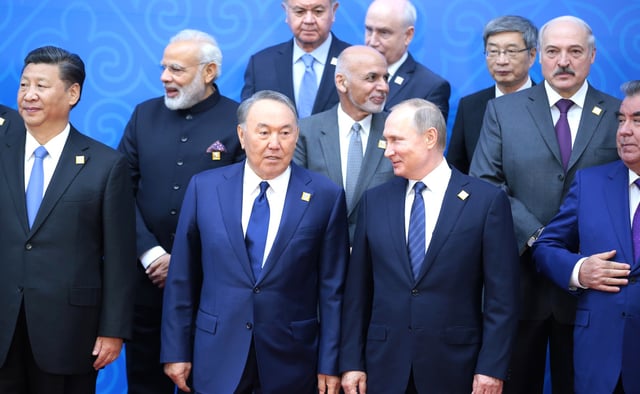
Nazarbayev and Russian President Vladimir Putin during the 2017 SCO Council of Heads of State meeting in Nur-Sultan.
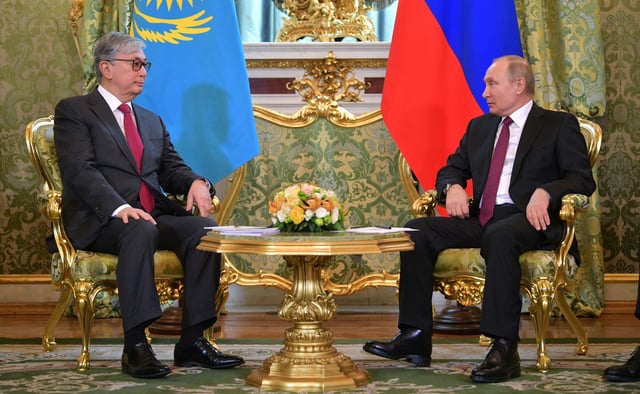
President Kassym-Jomart Tokayev with president of Russia Vladimir Putin in 2019
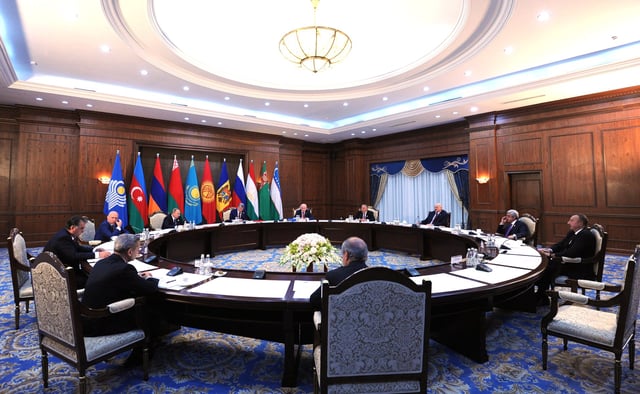
Meeting of CIS Council of Heads of State. 16 September 2016. Bishkek.
Kazakhstan is a member of the Commonwealth of Independent States, the Economic Cooperation Organization and the Shanghai Cooperation Organization. The nations of Kazakhstan, Russia, Belarus, Kyrgyzstan and Tajikistan established the Eurasian Economic Community in 2000, to revive earlier efforts to harmonise trade tariffs and to create a free trade zone under a customs union. On 1 December 2007, it was announced that Kazakhstan had been chosen to chair the Organization for Security and Co-operation in Europe for the year 2010. Kazakhstan was elected a member of the UN Human Rights Council for the first time on 12 November 2012.[77]
Kazakhstan is also a member of the United Nations, Organization for Security and Cooperation in Europe, Euro-Atlantic Partnership Council, Turkic Council, and Organisation of Islamic Cooperation (OIC). It is an active participant in the North Atlantic Treaty Organisation Partnership for Peace program.[78]
In 1999, Kazakhstan had applied for observer status at the Council of Europe Parliamentary Assembly. The official response of the Assembly was that because Kazakhstan is partially located in Europe,it could apply for full membership, but that it would not be granted any status whatsoever at the Council until its democracy and human rights records improved.
Since independence in 1991, Kazakhstan has pursued what is known as the "multivector foreign policy" (Kazakh: көпвекторлы сыртқы саясат), seeking equally good relations with its two large neighbours, Russia and China, as well as with the United States and the rest of the Western world.[79][80] Russia currently leases approximately 6,000 square kilometres (2,317 sq mi) of territory enclosing the Baikonur Cosmodrome space launch site in south central Kazakhstan, where the first man was launched into space as well as Soviet space shuttle Buran and the well-known space station Mir.
On 11 April 2010, Presidents Nazarbayev and Obama met at the Nuclear Security Summit in Washington, D.C., and discussed strengthening the strategic partnership between the United States and Kazakhstan. They pledged to intensify bilateral co-operation to promote nuclear safety and non-proliferation, regional stability in Central Asia, economic prosperity, and universal values.[81]
In April 2011, President Obama called President Nazarbayev and discussed many cooperative efforts regarding nuclear security, including securing nuclear material from the BN-350 reactor. They reviewed progress on meeting goals that the two presidents established during their bilateral meeting at the Nuclear Security Summit in 2010.[82] Since 2014 the Kazakhstani government has been bidding for a non-permanent member seat on the UN Security Council for 2017–2018.[83] On 28 June 2016 Kazakhstan was elected as a non-permanent member to serve on the UN Security Council for a two-year term.[84]
Kazakhstan actively supports UN peacekeeping missions in Haiti, the Western Sahara, and Côte d'Ivoire.[85] In March 2014, the Ministry of Defense chose 20 Kazakhstani military men as observers for the UN peacekeeping missions. The military personnel, ranking from captain to colonel, had to go through a specialised UN training; they had to be fluent in English and skilled in using specialised military vehicles.[85]
In 2014, Kazakhstan gave Ukraine humanitarian aid during the conflict with Russian-backed rebels. In October 2014, Kazakhstan donated $30,000 to the International Committee of the Red Cross's humanitarian effort in Ukraine. In January 2015, to help the humanitarian crisis, Kazakhstan sent $400,000 of aid to Ukraine's southeastern regions.[86] President Nazarbayev said of the war in Ukraine, "The fratricidal war has brought true devastation to eastern Ukraine, and it is a common task to stop the war there, strengthen Ukraine’s independence and secure territorial integrity of Ukraine."[87] Experts believe that no matter how the Ukraine crisis develops, Kazakhstan's relations with the European Union will remain normal.[88] It is believed that Nazarbayev's mediation is positively received by both Russia and Ukraine.[88]
Kazakhstan's Ministry of Foreign Affairs released a statement on 26 January 2015: "We are firmly convinced that there is no alternative to peace negotiations as a way to resolve the crisis in south-eastern Ukraine."[89] In 2018, Kazakhstan signed the UN treaty on the Prohibition of Nuclear Weapons.[90]
Military
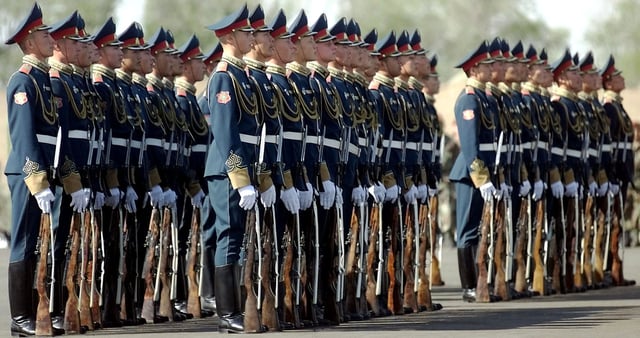
Kazakhstan Republican Guard
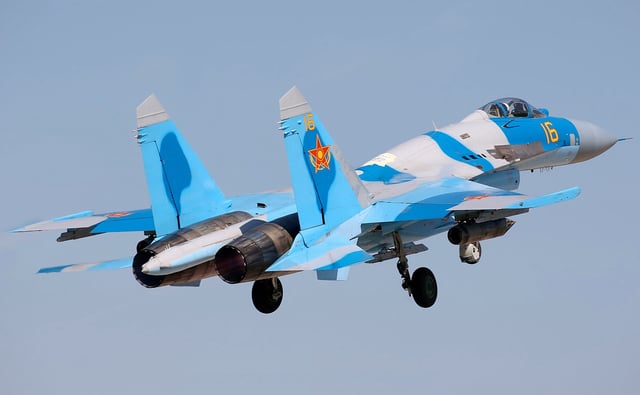
A Kazakhstan Sukhoi Su-27
Most of Kazakhstan's military was inherited from the Soviet Armed Forces' Turkestan Military District. These units became the core of Kazakhstan's new military. It acquired all the units of the 40th Army (the former 32nd Army) and part of the 17th Army Corps, including six land-force divisions, storage bases, the 14th and 35th air-landing brigades, two rocket brigades, two artillery regiments, and a large amount of equipment that had been withdrawn from over the Urals after the signing of the Treaty on Conventional Armed Forces in Europe. Since the late 20th century, the Kazakhstan Army has focused on expanding the number of its armoured units. Since 1990, armoured units have expanded from 500 to 1,613 in 2005.
The Kazakh air force is composed mostly of Soviet-era planes, including 41 MiG-29s, 44 MiG-31s, 37 Su-24s and 60 Su-27s. A small naval force is maintained on the Caspian Sea.
Kazakhstan sent 49 military engineers to Iraq to assist the US post-invasion mission in Iraq. During the second Iraq War, Kazakhstani troops dismantled 4 million mines and other explosives, helped provide medical care to more than 5,000 coalition members and civilians, and purified 718 cubic metres (25,356 cu ft) of water.[91]
Kazakhstan's National Security Committee (UQK) was established on 13 June 1992. It includes the Service of Internal Security, Military Counterintelligence, Border Guard, several Commando units, and Foreign Intelligence (Barlau). The latter is considered as the most important part of KNB. Its director is Nurtai Abykayev.
Since 2002, the joint tactical peacekeeping exercise "Steppe Eagle" has been hosted by the Kazakhstan government. "Steppe Eagle" focuses on building coalitions and gives participating nations the opportunity to work together. During the Steppe Eagle exercises, the Kazbat peacekeeping battalion operates within a multinational force under a unified command within multidisciplinary peacekeeping operations, with NATO and the US Military.[92]
In December 2013, Kazakhstan announced it will send officers to support United Nations Peacekeeping forces in Haiti, Western Sahara, Ivory Coast and Liberia.[93]
Human rights
Kazakhstan's human rights situation is described as poor by independent observers. The 2015 Human Rights Watch report on Kazakhstan said that the country "heavily restricts freedom of assembly, speech, and religion. In 2014, authorities closed newspapers, jailed or fined dozens of people after peaceful but unsanctioned protests, and fined or detained worshipers for practising religion outside state controls. Government critics, including opposition leader Vladimir Kozlov, remained in detention after unfair trials. In mid-2014, Kazakhstan adopted new criminal, criminal executive, criminal procedural, and administrative codes, and a new law on trade unions, which contain articles restricting fundamental freedoms and are incompatible with international standards. Torture remains common in places of detention."[94] The 2016 Human Rights Watch report commented that Kazakhstan "took few meaningful steps to tackle a worsening human rights record in 2015, maintaining a focus on economic development over political reform."[95]
According to a US government report released in 2014, in Kazakhstan:
"The law does not require police to inform detainees that they have the right to an attorney, and police did not do so. Human rights observers alleged that law enforcement officials dissuaded detainees from seeing an attorney, gathered evidence through preliminary questioning before a detainee’s attorney arrived, and in some cases used corrupt defence attorneys to gather evidence. [...]"[96] "The law does not adequately provide for an independent judiciary. The executive branch sharply limited judicial independence. Prosecutors enjoyed a quasi-judicial role and had the authority to suspend court decisions. Corruption was evident at every stage of the judicial process. Although judges were among the most highly paid government employees, lawyers and human rights monitors alleged that judges, prosecutors, and other officials solicited bribes in exchange for favourable rulings in the majority of criminal cases."[96]
Kazakhstan's global rank in the World Justice Project's 2015 Rule of Law Index was 65 out of 102; the country scored well on "Order and Security" (global rank 32/102), and poorly on "Constraints on Government Powers" (global rank 93/102), "Open Government" (85/102) and "Fundamental Rights" (84/102, with a downward trend marking a deterioration in conditions).[97]
Kazakhstan's Supreme Court has taken recent steps to modernise and to increase transparency and oversight over the country's legal system. With funding from the US Agency for International Development, the ABA Rule of Law Initiative began a new program in April 2012 to strengthen the independence and accountability of Kazakhstan's judiciary.[100]
In an effort to increase transparency in the criminal justice and court system, and improve human rights, Kazakhstan intends to digitize all investigative, prosecutorial and court records by 2018.[101]
Economy
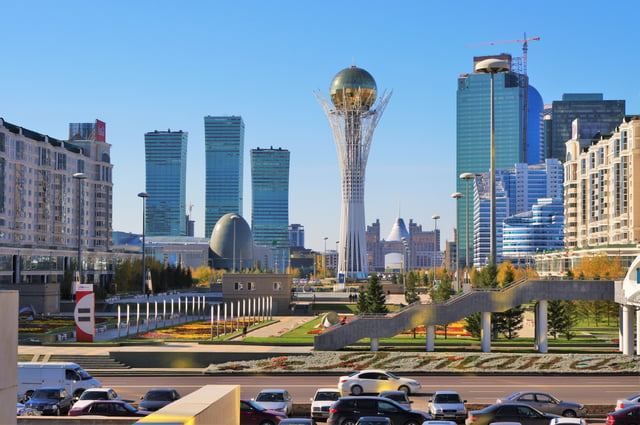
Downtown of Nur-Sultan

Khan Shatyr Entertainment Center in Nur-Sultan.

Aktau is Kazakhstan's only seaport on the Caspian Sea
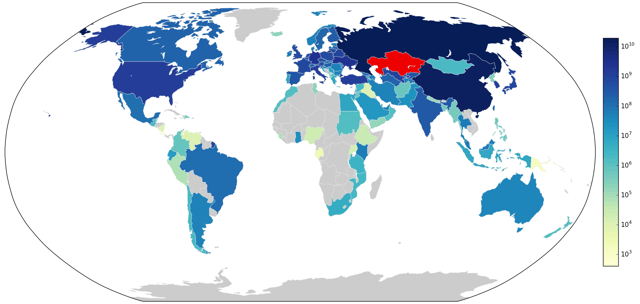
A map of Kazakhstan's imports, 2013
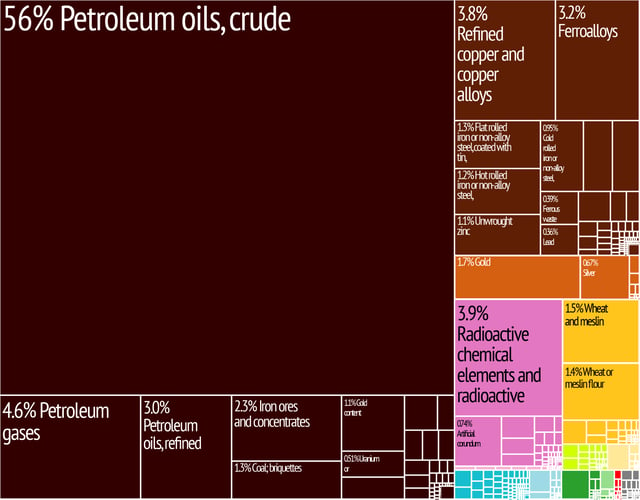
A proportional representation of Kazakhstan's exports.
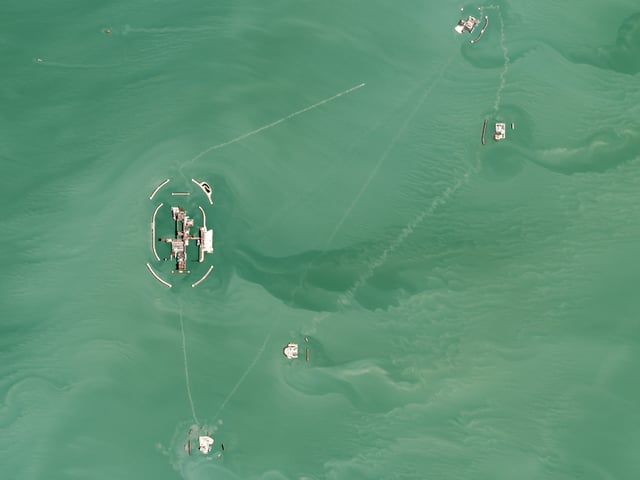
Aerial view of Kashagan Oil Field structures
Kazakhstan has the largest and strongest performing economy in Central Asia. Supported by rising oil output and prices, Kazakhstan's economy grew at an average of 8% per year until 2013, before suffering a slowdown in 2014 and 2015[105] Kazakhstan was the first former Soviet Republic to repay all of its debt to the International Monetary Fund, 7 years ahead of schedule.[106]
Buoyed by high world crude oil prices, GDP growth figures were between 8.9% and 13.5% from 2000 to 2007 before decreasing to 1–3% in 2008 and 2009, and then rising again from 2010.[107] Other major exports of Kazakhstan include wheat, textiles, and livestock. Kazakhstan is a leading exporter of uranium.[108][109]
Kazakhstan's economy grew by 4.6% in 2014.[110] The country experienced a slowdown in economic growth from 2014 sparked by falling oil prices and the effects of the Ukrainian crisis[111] The country devalued its currency by 19% in February 2014.[112] Another 22% devaluation occurred in August 2015.[113]
Kazakhstan's fiscal situation is stable. The government has continued to follow a conservative fiscal policy by controlling budget spending and accumulating oil revenue savings in its Oil Fund – Samruk-Kazyna. The global financial crisis forced Kazakhstan to increase its public borrowing to support the economy. Public debt increased to 13.4 per cent in 2013 from 8.7 per cent in 2008. Between 2012 and 2013, the government achieved an overall fiscal surplus of 4.5 per cent.[114]
Since 2002, Kazakhstan has sought to manage strong inflows of foreign currency without sparking inflation. Inflation has not been under strict control, however, registering 6.6% in 2002, 6.8% in 2003, and 6.4% in 2004.
In March 2002, the US Department of Commerce granted Kazakhstan market economy status under US trade law. This change in status recognised substantive market economy reforms in the areas of currency convertibility, wage rate determination, openness to foreign investment, and government control over the means of production and allocation of resources.
Kazakhstan weathered the global financial crisis well, by combining fiscal relaxation with monetary stabilisation. In 2009, the government introduced large-scale support measures such as the recapitalisation of banks and support for the real estate and agricultural sectors, as well as for small and medium enterprises (SMEs). The total value of the stimulus programs amounted to $21 billion, or 20 per cent of the country's GDP, with $4 billion going to stabilise the financial sector.[115] During the global economic crisis, Kazakhstan's economy contracted by 1.2% in 2009, while the annual growth rate subsequently increased to 7.5% and 5% in 2011 and 2012, respectively.[105]
In September 2002, Kazakhstan became the first country in the CIS to receive an investment grade credit rating from a major international credit rating agency. As of late December 2003, Kazakhstan's gross foreign debt was about $22.9 billion. Total governmental debt was $4.2 billion, 14% of GDP. There has been a reduction in the ratio of debt to GDP. The ratio of total governmental debt to GDP in 2000, was 21.7%; in 2001, it was 17.5%, and in 2002, it was 15.4%.
Economic growth, combined with earlier tax and financial sector reforms, has dramatically improved government finance from the 1999 budget deficit level of 3.5% of GDP to a deficit of 1.2% of GDP in 2003. Government revenues grew from 19.8% of GDP in 1999 to 22.6% of GDP in 2001, but decreased to 16.2% of GDP in 2003. In 2000, Kazakhstan adopted a new tax code in an effort to consolidate these gains.
On 29 November 2003, the Law on Changes to Tax Code which reduced tax rates was adopted. The value added tax fell from 16% to 15%, the social tax, from 21% to 20%, and the personal income tax, from 30% to 20%. On 7 July 2006, the personal income tax was reduced even further to a flat rate of 5% for personal income in the form of dividends and 10% for other personal income. Kazakhstan furthered its reforms by adopting a new land code on 20 June 2003, and a new customs code on 5 April 2003.
Energy is the leading economic sector. Production of crude oil and natural gas condensate from the oil and gas basins of Kazakhstan amounted to 79.2 million tonnes (77.9 million long tons; 87.3 million short tons) in 2012 up from 51.2 million tonnes (50.4 million long tons; 56.4 million short tons) in 2003. Kazakhstan raised oil and gas condensate exports to 44.3 million tons in 2003, 13% higher than in 2002. Gas production in Kazakhstan in 2003, amounted to 13.9 billion cubic metres (490 billion cubic feet), up 22.7% compared to 2002, including natural gas production of 7.3 billion cubic metres (260 billion cubic feet). Kazakhstan holds about 4 billion tonnes (3.9 billion long tons; 4.4 billion short tons) of proven recoverable oil reserves and 2,000 cubic kilometres (480 cubic miles) of gas. According to industry analysts, expansion of oil production and the development of new fields will enable the country to produce as much as 3 million barrels (480,000 m3) per day by 2015, and Kazakhstan would be among the top 10 oil-producing nations in the world. Kazakhstan's oil exports in 2003, were valued at more than $7 billion, representing 65% of overall exports and 24% of the GDP. Major oil and gas fields and recoverable oil reserves are Tengiz with 7 billion barrels (1.1 billion cubic metres); Karachaganak with 8 billion barrels (1.3 billion cubic metres) and 1,350 cubic kilometres (320 cubic miles) of natural gas; and Kashagan with 7 to 9 billion barrels (1.4 billion cubic metres).
Kazakhstan instituted an ambitious pension reform program in 1998. As of 1 January 2012, the pension assets were about $17 billion (KZT 2.5 trillion). There are 11 saving pension funds in the country. The State Accumulating Pension Fund, the only state-owned fund, was privatised in 2006. The country's unified financial regulatory agency oversees and regulates the pension funds. The growing demand of the pension funds for quality investment outlets triggered rapid development of the debt securities market. Pension fund capital is being invested almost exclusively in corporate and government bonds, including government of Kazakhstan Eurobonds. The government of Kazakhstan is studying a project to create a unified national pension fund and transfer all the accounts from the private pension funds into it.[116]
The banking system of Kazakhstan is developing rapidly and the system's capitalisation now exceeds $1 billion. The National Bank has introduced deposit insurance in its campaign to strengthen the banking sector. Due to troubling and non-performing bad assets the bank sector yet is at risk to lose stability. Several major foreign banks have branches in Kazakhstan, including RBS, Citibank, and HSBC. Kookmin and UniCredit have both recently entered the Kazakhstan's financial services market through acquisitions and stake-building.
During the first half of 2013, Kazakhstan's fixed investment increased 7.1% compared to the same period in 2012 totalling 2.8 trillion tenge ($18 billion US dollars).[120]
In 2013, Aftenposten quoted the human-rights activist and lawyer Denis Jivaga as saying that there is an "oil fund in Kazakhstan, but nobody knows how the income is spent".[121]
Kazakhstan climbed to 41st on the 2018 Economic Freedom Index published by the Wall Street Journal and The Heritage Foundation.[122]
Kazakhstan's economy grew at an average of 8% per year over the past decade on the back of hydrocarbon exports.[105] Despite the lingering uncertainty of the global economy, Kazakhstan's economy has been stable. GDP growth in January–September 2013 was 5.7%, according to preliminary calculations of the Ministry Economy and Budget Planning.[123]
From January to September 2014 Kazakhstan's GDP grew at 4%.[124] According to the results from the first half of the year, the current account surplus is $6.6 billion, a figure two times higher than that of the first half of 2013.[124] According to the Chairman of the National Bank of Kazakhstan, Kairat Kelimbetov, the increase was caused by a trade surplus of 17.4 percent, or approximately US$22.6 billion.[124] The overall inflation rate for 2014 is forecasted at 7.4 percent.[124]
China is one of the main economic and trade partners of Kazakhstan. In 2013, China launched the Belt and Road Initiative (BRI) where Kazakhstan is given an important role as a transit hub.[125]
Agriculture
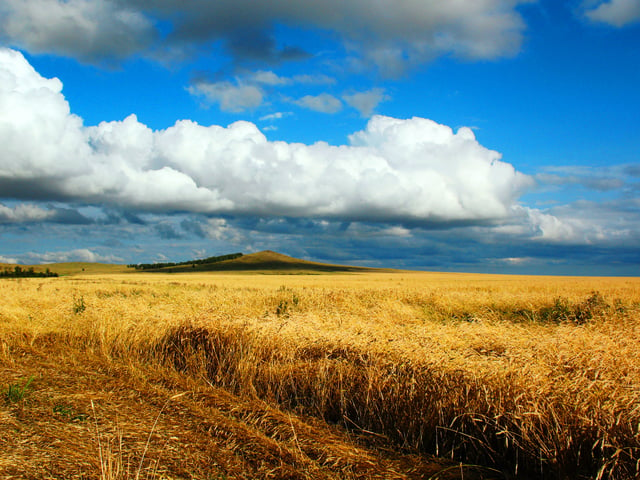
Grain fields near Kokshetau
Agriculture accounts for approximately 5% of Kazakhstan's GDP.[6] Grain, potatoes, grapes, vegetables, melons and livestock are the most important agricultural commodities. Agricultural land occupies more than 846,000 square kilometres (327,000 sq mi). The available agricultural land consists of 205,000 square kilometres (79,000 sq mi) of arable land and 611,000 square kilometres (236,000 sq mi) of pasture and hay land. Over 80% of the country's total area is classified as agricultural land, including almost 70% occupied by pasture. Its arable land has the second highest availability per inhabitant (1.5 hectares).[126]
Chief livestock products are dairy products, leather, meat, and wool. The country's major crops include wheat, barley, cotton, and rice. Wheat exports, a major source of hard currency, rank among the leading commodities in Kazakhstan's export trade. In 2003 Kazakhstan harvested 17.6 million tons of grain in gross, 2.8% higher compared to 2002. Kazakhstani agriculture still has many environmental problems from mismanagement during its years in the Soviet Union. Some Kazakh wine is produced in the mountains to the east of Almaty.
Kazakhstan is thought to be one of the places that the apple originated, particularly the wild ancestor of Malus domestica, Malus sieversii.[127] It has no common name in English, but is known in its native Kazakhstan as alma. The region where it is thought to originate is called Almaty: "rich with apple".[128] This tree is still found wild in the mountains of Central Asia, in southern Kazakhstan, Kyrgyzstan, Tajikistan and Xinjiang in China.
Infrastructure
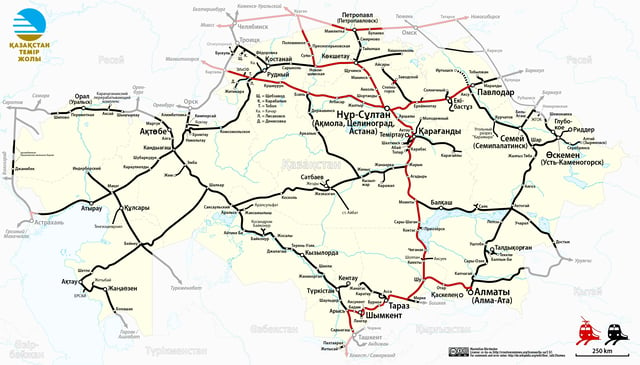
Map of Kazakhstan railway network
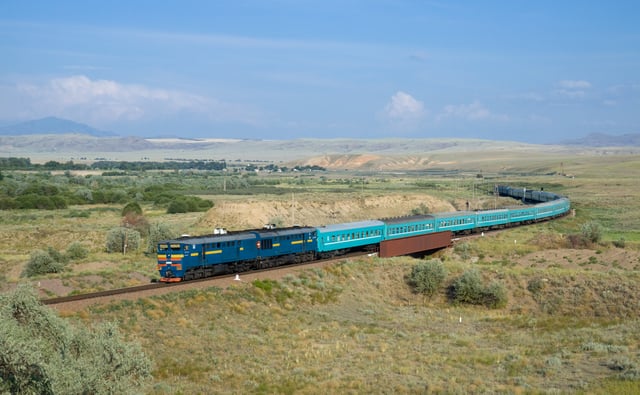
Train 22 Kyzylorda – Semipalatinsk, hauled by a Kazakhstan Temir Zholy 2TE10U diesel locomotive. Picture taken near Aynabulak, Kazakhstan.
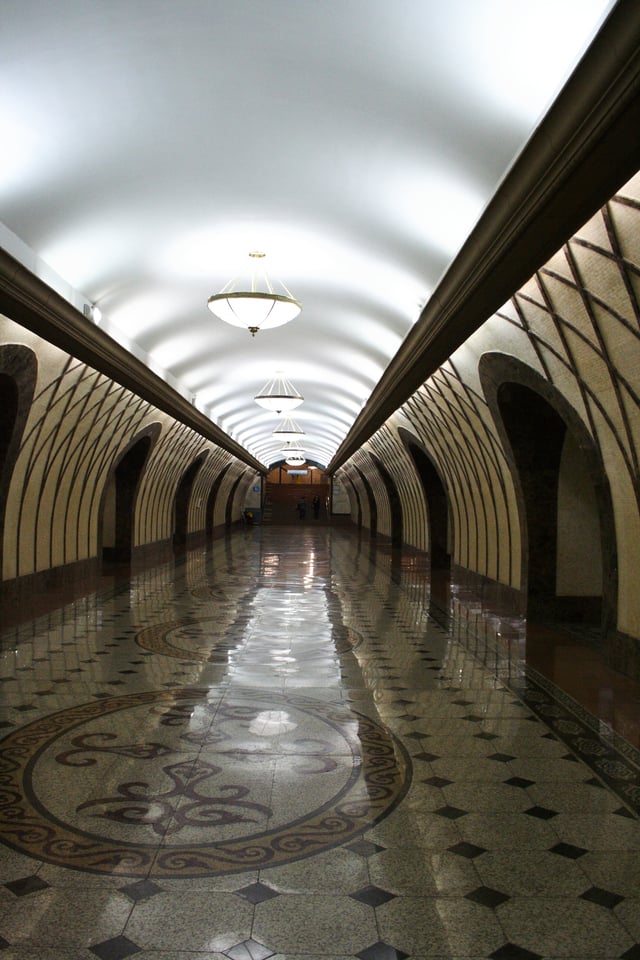
Metro station in Almaty.
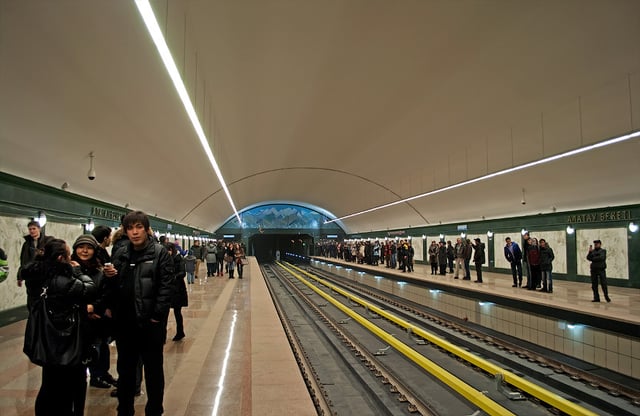
Almaty Metro
Railways provide 68% of all cargo and passenger traffic to over 57% of the country. There are 15,333 km (9,527 mi) in common carrier service, excluding industrial lines.[129]15,333 km (9,527 mi) of 1,520 mm (4 ft 11 27⁄32 in) gauge, 4,000 km (2,500 mi) electrified, in 2012.[129] Most cities are connected by railroad; high-speed trains go from Almaty (the southernmost city) to Petropavl (the northernmost city) in about 18 hours.
Kazakhstan Temir Zholy (KTZ) is the national railway company. KTZ cooperates with French loco manufacturer Alstom in developing Kazakhstan's railway infrastructure. Alstom has more than 600 staff and two joint ventures with KTZ and its subsidiary in Kazakhstan.[130] In July 2017, Alstom opened its first locomotive repairing center in Kazakhstan. It is the only repairing center in Central Asia and the Caucasus.[131]
As the Kazakhstani rail system was designed during the Soviet era, rail routes were designed ignoring intersoviet borders and to the needs of Soviet planning. This has caused anamolies such as the route from Oral to Aktobe now passes briefly through Russian territory. It also means that routes might not suit modern-day Kazakhstani needs.
Astana Nurly Zhol railway station, the most modern railway station in Kazakhstan, was opened in Nur-Sultan on 31 May 2017. The opening of the station coincided with the start of the Expo 2017 international exhibition. According to Kazakhstan Railways (KTZ), the 120,000m2 station is expected to be used by 54 trains a day and has capacity to handle 35,000 passengers a day.[132]
The strategy of transport development in Kazakhstan until 2015 is to build 1,600 km (990 mi) of new electrified and 2,700 km (1,700 mi) of existing railway stations.
There is a small 8.56 km (5.32 mi) metro system in Almaty. A second and third metro lines are planned in the future. The second line would intersect with the first line at Alatau and Zhibek Zholy stations.[133] In May 2011, the construction of the second phase of the Almaty Metro line 1 began. The general contractor is Almatymetrokurylys. Currently more than 300 m (980 ft) of tunnels on the extension project have been excavated. The extension includes five new stations, and will connect the downtown area of Almaty with Kalkaman in the suburbs. Its length will be 8.62 km (5.36 mi).[134] The construction is divided into 3 phases. The first phase (the current phase) will be the addition of two stations: Sairan and Moscow, a length of 2.7 km (1.7 mi).[134] For more details see: Almaty Metro.There was a tram system of 10 lines which operated from 1937 to 2015.[135]
The Astana Metro system is under construction. It's been a long time coming and the project was abandoned at one point in 2013,[136] but an agreement was signed on 7 May 2015 for the project to go ahead.[137] The system was opened between 1959 and 1978, and the tram was a popular form of transport in Oskemen/Ust-Kamenogorsk until its closure in 2018.[138] At its peak it had six routes, but in the end it had four routes in operation. It had a fleet of 50 working tram cars.[139] There is an 86 km (53 mi) tram network, which began service in 1965 with, As of 2012, 20 regular and three special routes. The network has a 60% share of the local public transport market. Its fleet of 115 trams are due to be replaced and in 2012, the city announced plans to purchase 100 new trams.[140] There are two tram lines in this city.[141]
The Khorgos Gateway dry port is one of Kazakhstan's primary dry ports for handling trans-Eurasian trains, which travel more than 9,000 km (5,600 mi) between China and Europe. The Khorgos Gateway dry port is surrounded by Khorgos Eastern Gate SEZ that officially commenced operations in December 2016.[142]
In 2009 the European Commission blacklisted all Kazakh air carriers with a sole exception of Air Astana. Since then, Kazakhstan has consistently taken measures to modernize and revamp its air safety oversight. In 2016 the European air safety authorities removed all Kazakh airlines from the blacklist and there was "sufficient evidence of compliance" with international standards by Kazakh Airlines and the Civil Aviation Committee.[143]
Tourism
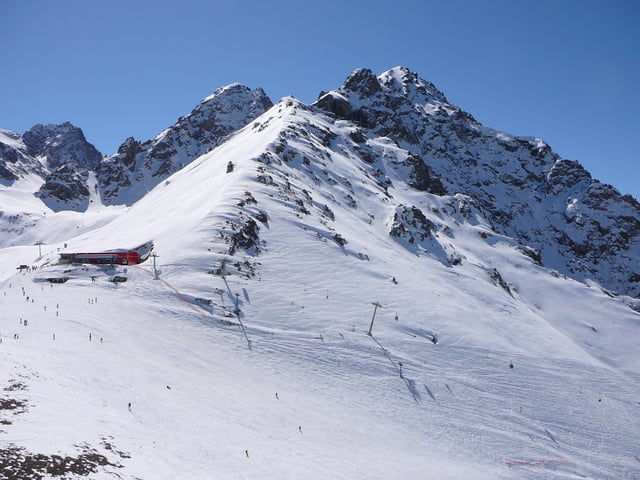
A ski resort in Almaty.
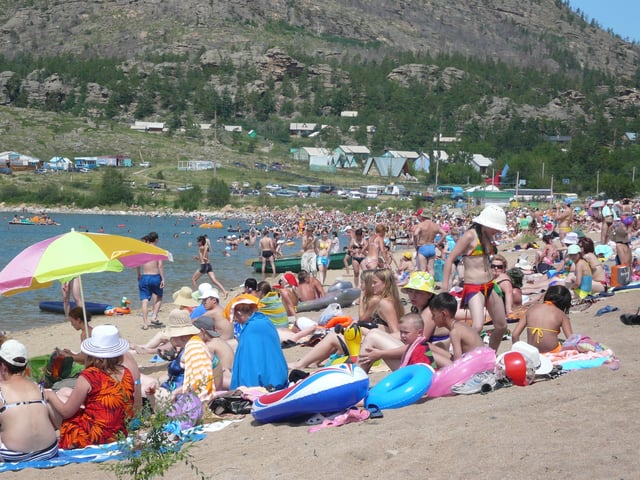
Kazakhstanis on a Lake Jasybay beach, Pavlodar Region
Kazakhstan is the ninth-largest country by area and the largest landlocked country. Today, tourism is not a major component of the economy. As of 2014, tourism has accounted for 0.3% of Kazakhstan's GDP, but the government has plans to increase it to 3% by 2020.[144][145] According to the World Economic Forum's Travel and Tourism Competitiveness Report 2017, travel and tourism industry GDP in Kazakhstan is $3.08 billion or 1.6 percent of total GDP. The WEF ranks Kazakhstan 81st in its 2017 report, which is four positions higher compared to the previous period.[146] Kazakhstan received 6.5 million tourists in 2016.
In 2012, Kazakhstan ranked 51st in the world in terms of number of tourist arrivals. In 2000 total 1.47 million international tourists visited Kazakhstan, which was increased to 4.81 million in 2012.[147] The Guardian describes tourism in Kazakhstan as, "hugely underdeveloped", despite the attractions of the country's dramatic mountain, lake and desert landscapes.[148] Factors hampering an increase in tourist visits are said to include high prices, "shabby infrastructure", "poor service" and the logistical difficulties of travel in a geographically enormous, underdeveloped country.[148] Even for locals, going for holiday abroad may cost only half the price of taking a holiday in Kazakhstan.[148]
The Kazakh Government, long characterized as authoritarian with a history of human rights abuses and suppression of political opposition,[17] has started an initiative named the "Tourism Industry Development Plan 2020". This initiative aims to establish five tourism clusters in Kazakhstan: Nur-Sultan city, Almaty city, East Kazakhstan, South Kazakhstan, and West Kazakhstan Oblasts. It also seeks investment of $4 billion and the creation of 300,000 new jobs in the tourism industry by 2020.[149][148]
Kazakhstan offers a permanent visa-free regime for up to 90 days to citizens of Armenia, Belarus, Georgia, Moldova, Kyrgyzstan, Mongolia, Russia and Ukraine and for up to 30 days to citizens of Argentina, Azerbaijan, Serbia, South Korea, Tajikistan, Turkey and Uzbekistan.[150]
Kazakhstan established a visa-free regime for citizens of 45 countries, including European Union and OECD member states, the US, the UAE, South Korea, Australia, and New Zealand.[151]
Green economy

Astana Expo 2017 "Nur Alem" Pavilion
The government has set the goals that a transition to the Green Economy in Kazakhstan occur by 2050. The green economy is projected to increase GDP by 3% and create more than 500,000 new jobs.[152]
The government of Kazakhstan has set prices for energy produced from renewable sources. The price of 1 kilowatt-hour for energy produced by wind power plants was set at 22.68 tenge ($0.12). The price for 1 kilowatt-hour produced by small hydro-power plants is 16.71 tenge ($0.09), and from biogas plants 32.23 tenge ($0.18).[153]
Foreign direct investment
As of 2014, foreign investors had placed a total of $211.5 billion in Kazakhstan.[154] According to the US State Department, Kazakhstan is widely considered to have the best investment climate in the region.[154] In 2002 the country became the first sovereign in the former Soviet Union to receive an investment-grade credit rating from an international credit rating agency. Foreign direct investment (FDI) plays a more significant role in the national economy than in most other former Soviet republics.[155]
President Nazarbayev signed into law tax concessions to promote foreign direct investment which include a ten-year exemption from corporation tax, an eight-year exemption from property tax, and a ten-year freeze on most other taxes.[156] Other incentives include a refund on capital investments of up to 30 percent once a production facility is in operation.[156]
Sir Suma Chakrabarti, the president of the European Bank of Reconstruction and Development (EBRD), cochaired the Kazakhstan Foreign Investors’ Council with President Nursultan Nazarbayev.[157] In May 2014, the EBRD and government of Kazakhstan created the Partnership for Re-Energizing the Reform Process in Kazakhstan to work with international financial institutions to channel US$2.7 billion provided by the Kazakh government into important sectors of Kazakhstan's economy.[158] The partnership will boost investment and drive forward reforms in the country.[158]
As of May 2014, Kazakhstan attracted $190 billion in gross foreign investments since its independence in 1991 and it leads the CIS countries in terms of FDI attracted per capita.[159] One of the factors that attract foreign direct investments is country's political stability. According to the World Bank's report, Kazakhstan is among the top 40% of countries in the world that are considered the most politically stable and free of violence.[160]
Kazakhstan also received high ratings in a survey conducted by Ernst & Young in 2014. According to EY's 2014 Kazakhstan Attractiveness Survey, "Investor confidence in Kazakhstan’s potential is also at an all-time high with 47.3% of respondents expecting Kazakhstan to become increasingly attractive over the next three years."[161] The high level of economic, political and social stability and Kazakhstan's competitive corporate tax rate were the primary reasons mentioned for its attractiveness.[161]
The OECD 2017 Investment Policy Review noted that "great strides" have been made to open up opportunities to foreign investors and improving policy to attract FDI.[162]
Banking
The banking industry of the Republic of Kazakhstan experienced a pronounced boom and bust cycle over 2000s decade. After several years of rapid expansion in the mid-2000s, the banking industry collapsed in 2008. Several large banking groups, including BTA Bank J.S.C. and Alliance Bank, defaulted soon after. Since then, the industry has shrunk and been restructured, with system-wide loans dropping to 39% of GDP in 2011 from 59% in 2007. Although the Russian and Kazakhstani banking systems share several common features, there are also some fundamental differences. Banks in Kazakhstan have experienced a lengthy period of political stability and economic growth. Together with a rational approach to banking and finance policy, this has helped push Kazakhstan's banking system to a higher level of development. Banking technology and personnel qualifications alike are stronger in Kazakhstan than in Russia. On the negative side, past stability in Kazakhstan arose from the concentration of virtually all political power in the hands of a single individual – the key factor in any assessment of system or country risk. The potential is there for serious disturbances if and when authority passes into new hands.[163]
Bond market
In October 2014, Kazakhstan introduced its first overseas dollar bonds in 14 years.[164] Kazakhstan issued $2.5 billion of 10- and 30-year bonds on 5 October 2014, in what was the nation's first dollar-denominated overseas sale since 2000.[164] Kazakhstan sold $1.5 billion of 10-year dollar bonds to yield 1.5 percentage points above midswaps and $1 billion of 30-year debt at two percentage points over midswaps.[164] The country drew bids for $11 billion.[164]
Housing market
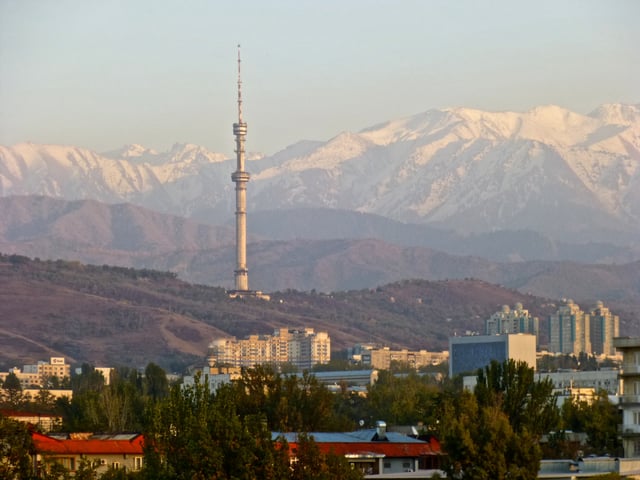
Almaty
The housing market of Kazakhstan has grown since 2010.[165] In 2013, the total housing area in Kazakhstan amounted to 336.1 million square metres (3,618 million square feet).[165] The housing stock rose over the year to 32.7 million squares, which is nearly an 11% increase.[165] Between 2012 and 2013, the living area per Kazakh citizen rose from 19.6 to 20.9 square metres (211 to 225 square feet).[165] The urban areas concentrate 62.5 percent of the country's housing stock.[165] The UN's recommended standard for housing stands at 30 square metres (320 square feet) per person.[165] Kazakhstan will be able to reach the UN standards by 2019 or 2020, if in the medium term the housing growth rate remains within 7 percent.[165]
"Nurly Jol" economic policy
On 11 November 2014, President of Kazakhstan Nursultan Nazarbayev delivered an unexpected state-of-the-nation address in Nur-Sultan at an extended session of the Political Council of the Nur Otan party, introducing a "Nurly Jol" (Bright Path), a new economic policy that implies massive state investment in infrastructure over the next several years.[166] The "Nurly Zhol" policy is accepted as preventive measures needed to help steer the economy towards sustainable growth in the context of the modern global economic and geopolitical challenges, such as the 25%-reduction in the oil price, reciprocal sanctions between the West and Russia over Ukraine, etc.[166] The policy embraces all aspects of economic growth, including finances, industry and social welfare, but especially emphasises investments into the development of infrastructure and construction works.[166] Given recent decreases in revenues from the export of raw materials, funds will be used from Kazakhstan's National Fund.[166]
Economic competitiveness
Kazakhstan achieved its goal of entering the top 50 most competitive countries in 2013, and has maintained its position in the 2014–2015 World Economic Forum Global Competitiveness Report that was published at the beginning of September 2014.[167] Kazakhstan is ahead of other states in the CIS in almost all of the report's pillars of competitiveness, including institutions, infrastructure, macroeconomic environment, higher education and training, goods market efficiency, labour market development, financial market development, technological readiness, market size, business sophistication and innovation, lagging behind only in the category of health and primary education.[167] The Global Competitiveness Index gives a score from 1 to 7 in each of these pillars, and Kazakhstan earned an overall score of 4.4.[167]
Corruption
In 2005, the World Bank listed Kazakhstan as a corruption hotspot, on a par with Angola, Bolivia, Kenya, Libya and Pakistan.[168] In 2012, Kazakhstan ranked low in an index of the least corrupt countries[169] and the World Economic Forum listed corruption as the biggest problem in doing business in the country.[169] A 2017 OECD report on Kazakhstan indicated that Kazakhstan has reformed laws with regard to the civil service, judiciary, instruments to prevent corruption, access to information, and prosecuting corruption.[170]
In 2011 Switzerland confiscated US$48 million in Kazakhstani assets from Swiss bank accounts, as a result of a bribery investigation in the United States.[171] US officials believed the funds represented bribes paid by American officials to Kazakhstani officials in exchange for oil or prospecting rights in Kazakhstan. Proceedings eventually involved US$84 million in the US and another US$60 million in Switzerland[171]
The Federal Bureau of Investigation and the Kazakh Anti-Corruption Agency signed a Mutual Legal Assistance Treaty in February 2015.[172]
Science and technology

Trends in research expenditure in Central Asia, as a percentage of GDP, 2001–2013. Source: UNESCO Science Report: 2030 (2015), Figure 14.3
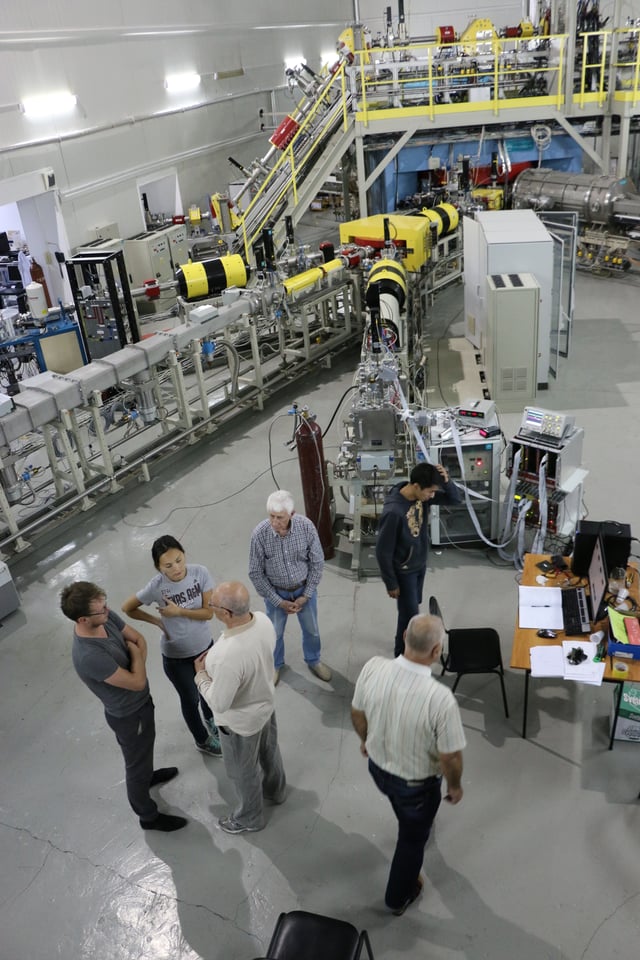
Group of Kazakhstan physicists in collaboration with Uzbek researchers working at the ion accelerator DC-60
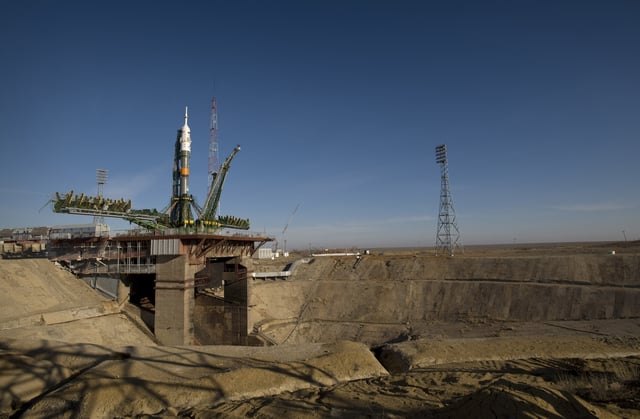
Baikonur Cosmodrome is the world's oldest and largest operational space launch facility.
Research remains largely concentrated in Kazakhstan's largest city and former capital, Almaty, home to 52% of research personnel. Public research is largely confined to institutes, with universities making only a token contribution. Research institutes receive their funding from national research councils under the umbrella of the Ministry of Education and Science. Their output, however, tends to be disconnected from market needs. In the business sector, few industrial enterprises conduct research themselves.[173][174]
One of the most ambitious targets of the State Programme for Accelerated Industrial and Innovative Development adopted in 2010 is to raise the country's level of expenditure on research and development to 1% of GDP by 2015. By 2013, this ratio stood at 0.18% of GDP. It will be difficult to reach the target as long as economic growth remains strong. Since 2005, the economy has grown faster (by 6% in 2013) than gross domestic expenditure on research and development, which only progressed from PPP$598 million to PPP$714 million between 2005 and 2013.[174]
Innovation expenditure more than doubled in Kazakhstan between 2010 and 2011, representing KZT 235 billion (circa US$1.6 billion), or around 1.1% of GDP. Some 11% of the total was spent on research and development. This compares with about 40–70% of innovation expenditure in developed countries. This augmentation was due to a sharp rise in product design and the introduction of new services and production methods over this period, to the detriment of the acquisition of machinery and equipment, which has traditionally made up the bulk of Kazakhstan's innovation expenditure. Training costs represented just 2% of innovation expenditure, a much lower share than in developed countries.[173][174]
In December 2012, President Nursultan Nazarbayev announced the Kazakhstan 2050 Strategy with the slogan "Strong Business, Strong State." This pragmatic strategy proposes sweeping socio-economic and political reforms to hoist Kazakhstan among the top 30 economies by 2050. In this document, Kazakhstan gives itself 15 years to evolve into a knowledge economy. New sectors are to be created during each five-year plan. The first of these, covering the years 2010–2014, focused on developing industrial capacity in car manufacturing, aircraft engineering and the production of locomotives, passenger and cargo railroad cars. During the second five-year plan to 2019, the goal is to develop export markets for these products. To enable Kazakhstan to enter the world market of geological exploration, the country intends to increase the efficiency of traditional extractive sectors such as oil and gas. It also intends to develop rare earth metals, given their importance for electronics, laser technology, communication and medical equipment. The second five-year plan coincides with the development of the Business 2020 roadmap for small and medium-sized enterprises (SMEs), which makes provision for the allocation of grants to SMEs in the regions and for microcredit. The government and the National Chamber of Entrepreneurs also plan to develop an effective mechanism to help start-ups.[174]
During subsequent five-year plans to 2050, new industries will be established in fields such as mobile, multi-media, nano- and space technologies, robotics, genetic engineering and alternative energy. Food processing enterprises will be developed with an eye to turning the country into a major regional exporter of beef, dairy and other agricultural products. Low-return, water-intensive crop varieties will be replaced with vegetable, oil and fodder products. As part of the shift to a "green economy" by 2030, 15% of acreage will be cultivated with water-saving technologies. Experimental agrarian and innovational clusters will be established and drought-resistant genetically modified crops developed.[174]
The Kazakhstan 2050 Strategy fixes a target of devoting 3% of GDP to research and development by 2050 to allow for the development of new high-tech sectors.[174]
Demographics
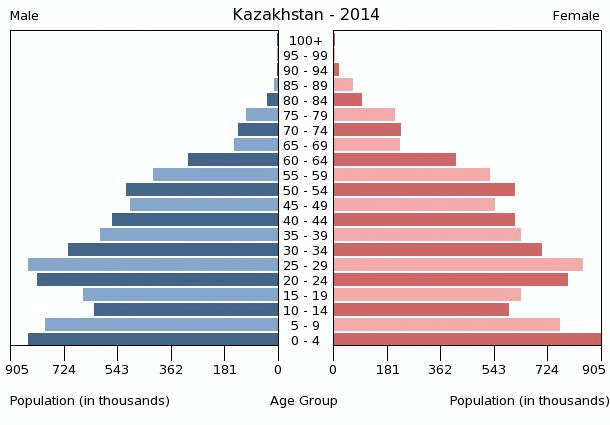
Population pyramid, 2014

Central Asian ethnolinguistic patchwork, 1992
The US Census Bureau International Database lists the population of Kazakhstan as 18.9 million (May 2019),[175] while United Nations sources such as the 2017 revision of the World Population Prospects[176] give an estimate of 17,987,736. Official estimates put the population of Kazakhstan at 18.459 million as of April 2019.[7] In 2013, Kazakhstan's population rose to 17,280,000 with a 1.7% growth rate over the past year according to the Kazakhstan Statistics Agency.[177]
The 2009 population estimate is 6.8% higher than the population reported in the last census from January 1999. The decline in population that began after 1989 has been arrested and possibly reversed. Men and women make up 48.3% and 51.7% of the population, respectively.
Ethnic groups
Ethnic Kazakhs are 63.1% of the population and ethnic Russians in Kazakhstan are 23.7%.[21] Other groups include Tatars (1.3%), Ukrainians (2.1%), Uzbeks (2.8%), Belarusians, Uyghurs (1.4%), Azerbaijanis, Dungans, Kalmyks, Chuvashes, Poles,[178] and Lithuanians. Some minorities such as Ukrainians, Koreans, Volga Germans (1.1%), Chechens,[179] Meskhetian Turks, and Russian political opponents of the regime, had been deported to Kazakhstan in the 1930s and 1940s by Stalin. Some of the largest Soviet labour camps (Gulag) existed in the country.[180]
Significant Russian immigration was also connected with the Virgin Lands Campaign and Soviet space program during the Khrushchev era.[181] In 1989, ethnic Russians were 37.8% of the population and Kazakhs held a majority in only 7 of the 20 regions of the country. Before 1991 there were about 1 million Germans in Kazakhstan, mostly descendants of the Volga Germans deported to Kazakhstan during World War II. After the break-up of the Soviet Union, most of them emigrated to Germany.[182] Most members of the smaller Pontian Greek minority have emigrated to Greece. In the late 1930s thousands of Koreans in the Soviet Union were deported to Central Asia. These people are now known as Koryo-saram.
The 1990s were marked by the emigration of many of the country's Russians and Volga Germans, a process that began in the 1970s. This has made indigenous Kazakhs the largest ethnic group. Additional factors in the increase in the Kazakhstani population are higher birthrates and immigration of ethnic Kazakhs from China, Mongolia, and Russia.
| Ethnic group | census 19261 | census 19702 | census 19893 | census 19994 | census 20095 | |||||||||||||
|---|---|---|---|---|---|---|---|---|---|---|---|---|---|---|---|---|---|---|
| Number | % | Number | % | Number | % | Number | % | Number | % | |||||||||
| Kazakhs | 3,627,612 | 58.5 | 4,161,164 | 32.4 | 6,534,616 | 39.7 | 8,011,452 | 53.5 | 10,096,763 | 63.1 | ||||||||
| Russians | 1,275,055 | 20.6 | 5,499,826 | 42.8 | 6,227,549 | 37.8 | 4,480,675 | 29.9 | 3,793,764 | 23.7 | ||||||||
| Uzbeks | 129,407 | 2.1 | 207,514 | 1.6 | 332,017 | 2.0 | 370,765 | 2.5 | 456,997 | 2.8 | ||||||||
| Ukrainians | 860,201 | 13.9 | 930,158 | 7.2 | 896,240 | 5.4 | 547,065 | 3.7 | 333,031 | 2.1 | ||||||||
| Germans | 51,094 | 0.8 | 839,649 | 6.5 | 957,518 | 5.8 | 353,462 | 2.4 | 178,409 | 1.1 | ||||||||
| 1Source:[183]2Source:[184]3Source:[185]4Source:[186]5Source:[21] | ||||||||||||||||||
Languages
Kazakhstan is officially a bilingual country. Kazakh, (part of the Kipchak family of Turkic languages)[187] spoken natively by 64.4% of the population, has the status of "state" language, whereas Russian, which is spoken by most Kazakhstanis,[188] is declared an "official" language, and is used routinely in business, government, and inter-ethnic communication, although Kazakh is slowly replacing it.[189]
The government announced in January 2015 that the Latin alphabet will replace Cyrillic as the writing system for the Kazakh language by 2025.[190] Other minority languages spoken in Kazakhstan include Uzbek, Ukrainian, Uyghur, Kyrgyz, and Tatar. English, as well as Turkish, have gained popularity among younger people since the collapse of the Soviet Union. Education across Kazakhstan is conducted in either Kazakh, Russian, or both.[191] In Nazarbayev's resignation speech of 2019, he projected that the people of Kazakhstan in the future will speak three languages (Kazakh, Russian and English).[192]
Religion
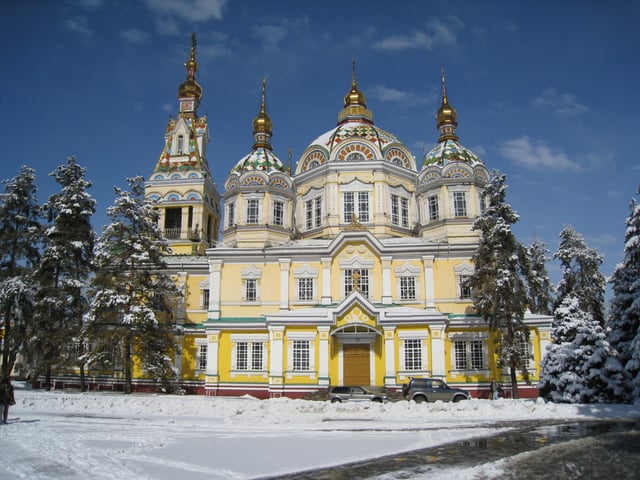
Ascension Cathedral in Almaty

Khazret Sultan Mosque is the biggest mosque in Kazakhstan
According to the 2009 Census, 70% of the population is Muslim, 26% Christian, 0.2% Buddhist, 0.1% other religions (mostly Jewish), and 3% irreligious, while 0.5% chose not to answer.[22] According to its Constitution, Kazakhstan is a secular state.
Religious freedoms are guaranteed by Article 39 of Kazakhstan's Constitution. Article 39 states: "Human rights and freedoms shall not be restricted in any way." Article 14 prohibits "discrimination on religious basis" and Article 19 ensures that everyone has the "right to determine and indicate or not to indicate his/her ethnic, party and religious affiliation." The Constitutional Council recently affirmed these rights by ruling that a proposed law limiting the rights of certain individuals to practice their religion was declared unconstitutional.
Islam is the largest religion in Kazakhstan, followed by Orthodox Christianity. After decades of religious suppression by the Soviet Union, the coming of independence witnessed a surge in expression of ethnic identity, partly through religion. The free practice of religious beliefs and the establishment of full freedom of religion led to an increase of religious activity. Hundreds of mosques, churches, and other religious structures were built in the span of a few years, with the number of religious associations rising from 670 in 1990 to 4,170 today.[195]
Some figures show that non-denominational Muslims[196] form the majority, while others indicate that most Muslims in the country are Sunnis following the Hanafi school.[197] These include ethnic Kazakhs, who constitute about 60% of the population, as well as ethnic Uzbeks, Uighurs, and Tatars.[198] Less than 1% are part of the Sunni Shafi`i school (primarily Chechens). There are also some Ahmadi Muslims.[199] There are a total of 2,300 mosques,[195] all of them are affiliated with the "Spiritual Association of Muslims of Kazakhstan", headed by a supreme mufti.[200] Unaffiliated mosques are forcefully closed.[201] Eid al-Adha is recognised as a national holiday.[195]
One quarter of the population is Russian Orthodox, including ethnic Russians, Ukrainians and Belarusians.[202] Other Christian groups include Roman Catholics, Greek Catholics, and Protestants.[198] There are a total of 258 Orthodox churches, 93 Catholic churches (9 Greek Catholic), and over 500 Protestant churches and prayer houses. The Russian Orthodox Christmas is recognized as a national holiday in Kazakhstan.[195] Other religious groups include Judaism, the Bahá'í Faith, Hinduism, Buddhism, and The Church of Jesus Christ of Latter-day Saints.[198]
According to the 2009 Census data, there are very few Christians outside the Slavic and Germanic ethnic groups.[203]
Education
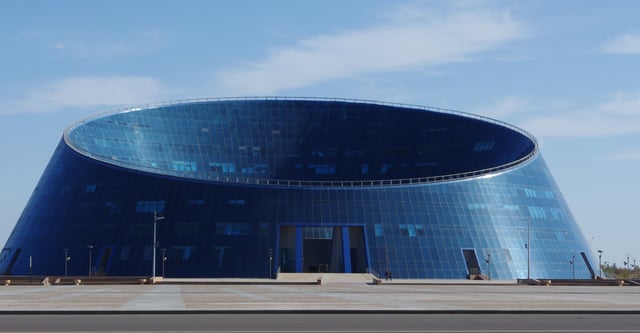
Kazakh National University of Arts
Education is universal and mandatory through to the secondary level and the adult literacy rate is 99.5%.[204] On average, these statistics are equal to both women and men Kazakhstan.[205]
Education consists of three main phases: primary education (forms 1–4), basic general education (forms 5–9) and senior level education (forms 10–11 or 12) divided into continued general education and vocational education. Vocational Education usually lasts three or four years.[206] (Primary education is preceded by one year of pre-school education.) These levels can be followed in one institution or in different ones (e.g., primary school, then secondary school). Recently, several secondary schools, specialised schools, magnet schools, gymnasiums, lyceums and linguistic and technical gymnasiums have been founded. Secondary professional education is offered in special professional or technical schools, lyceums or colleges and vocational schools.[204]
At present, there are universities, academies and institutes, conservatories, higher schools and higher colleges. There are three main levels: basic higher education that provides the fundamentals of the chosen field of study and leads to the award of the Bachelor's degree; specialised higher education after which students are awarded the Specialist's Diploma; and scientific-pedagogical higher education which leads to the Master's Degree. Postgraduate education leads to the Kandidat Nauk ("Candidate of Sciences") and the Doctor of Sciences (Ph.D.). With the adoption of the Laws on Education and on Higher Education, a private sector has been established and several private institutions have been licensed.
Over 2,500 students in Kazakhstan have applied for student loans totalling about $9 million. The largest number of student loans come from Almaty, Nur-Sultan and Kyzylorda.[207]
The training and skills development programs in Kazakhstan are also supported by international organisations. For example, on 30 March 2015, the World Banks' Group of Executive Directors approved a $100 million loan for the Skills and Job project in Kazakhstan.[208] The project aims to provide relevant training to unemployed, unproductively self-employed, and current employees in need of training.[208] In 2015, Kazakhstan reported a total unemployment rate of 5.0%, similar to some of the largest economic powers such as the USA.[209] Kazakhstan's youth unemployment (15-24 y.o. population) rate was also reported at 5.0% in 2017.[210]
Culture

A Kazakhstan performer demonstrates the long equestrian heritage as part of the gala concert during the opening ceremonies of the Central Asian Peacekeeping Battalion.

Kanysh Satpayev, one of the founders of Soviet era metallogeny, principal advocate and the first president of Kazakhstan Academy of Sciences.
Before the Russian colonisation, the Kazakhs had a highly developed culture based on their nomadic pastoral economy. Islam was introduced into the region with the arrival of the Arabs in the 8th century. It initially took hold in the southern parts of Turkestan and spread northward.[211] The Samanids helped the religion take root through zealous missionary work. The Golden Horde further propagated Islam amongst the tribes in the region during the 14th century.[212]
Kazakhstan is home to a large number of prominent contributors to literature, science and philosophy: Abay Qunanbayuli, Mukhtar Auezov, Gabit Musirepov, Kanysh Satpayev, Mukhtar Shakhanov, Saken Seyfullin, Jambyl Jabayev, among many others.
Tourism is a rapidly growing industry in Kazakhstan and it is joining the international tourism networking. In 2010, Kazakhstan joined The Region Initiative (TRI) which is a Tri-regional Umbrella of Tourism related organisations. TRI is functioning as a link between three regions: South Asia, Central Asia, and Eastern Europe. Armenia, Bangladesh, Georgia, Kazakhstan, Kyrgyzstan, India, Nepal, Pakistan, Russia, Sri Lanka, Tajikistan, Turkey, and Ukraine are now partners, and Kazakhstan is linked with other South Asian, Eastern European, and Central Asian countries in the tourism market.
Literature
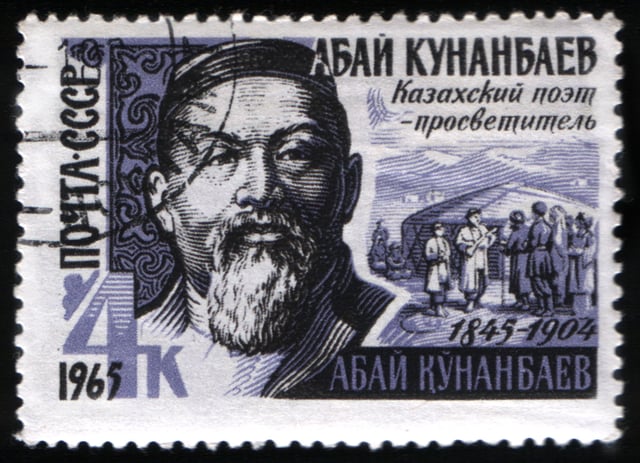
1965 post mark of Soviet Union honoring Kazakh essayist and poet Abai Qunanbaiuly.
Kazakh literature is defined as "the body of literature, both oral and written, produced in the Kazakh language by the Kazakh people of Central Asia".[213] Kazakh literature expands from the current territory of Kazakhstan, also including the era of Kazakh Soviet Socialist Republic, Kazakh recognized territory under the Russian Empire and the Kazakh Khanate. There is some overlap with several complementary themes, including the literature of Turkic tribes that inhabited Kazakhstan over the course of the history and literature written by ethnic Kazakhs.
According to Chinese written sources of 6th–8th centuries CE, Turkic tribes of Kazakhstan had oral poetry tradition. These came from earlier periods, and were primarily transmitted by bards: professional storytellers and musical performers.[214] Traces of this tradition are shown on Orkhon script stone carvings dated 5th–7th centuries CE that describe rule of Kultegin and Bilge, two early Turkic rulers ("kagans"). Amongst the Kazakhs, the bard was a primarily, though not exclusively, male profession. Since at least the 17th century, Kazakh bards could be divided in two main categories: the zhıraws (zhiraus, žyraus), who passed on the works of others, usually not creating and adding their own original work; and the aqyns (akyns), who improvised or created their own poems, stories or songs.[213] There were several types of works, such as didactic termes, elegiac tolgaws, and epic zhırs.[213] Although the origins of such tales are often unknown, most of them were associated with bards of the recent or more distant past, who supposedly created them or passed them on, by the time most Kazakh poetry and prose was first written down in the second half of the 19th century.[213] There are clear stylistic differences between works first created in the 19th century, and works dating from earlier periods but not documented before the 19th century, such as those attributed to such 16th- and 17th-century bards as Er Shoban and Dosmombet Zhıraw (also known as Dospambet Žyrau; he appeared to have been literate, and reportedly visited Constantinople), and even to such 15th-century bards as Shalkiz and Asan Qayghı.[213]
Other notable bards include Kaztugan Žyrau, Žiembet Žyrau, Axtamberdy Žyrau, and Buxar Žyrau Kalkamanuly, who was an advisor to Ablai Khan, and whose works have been preserved by Mäšhür Žüsip Köpeev.[214] Er Targhın and Alpamıs are two of the most famous examples of Kazakh literature to be recorded in the 19th century.[213] The Book of Dede Korkut and Oguz Name (a story of ancient Turkic king Oghuz Khan) are the most well-known Turkic heroic legends. Initially created around 9th century CE, they were passed on through generations in oral form. The legendary tales were recorded by Turkish authors in 14–16th centuries C.E.[215][216]
The preeminent role in the development of modern literary Kazakh belongs to Abai Qunanbaiuly (Kazakh: Абай Құнанбайұлы, sometimes russified to Abay Kunanbayev, Абай Кунанбаев) (1845–1904), whose writings did much to preserve Kazakh folk culture. Abai's major work is The Book of Words (Kazakh: қара сөздері, Qara sözderi), a philosophical treatise and collection of poems where he criticizes Russian colonial policies and encourages other Kazakhs to embrace education and literacy. The literary magazines Ay Qap (published between 1911 and 1915 in Arabic script) and Qazaq (published between 1913 and 1918) played an important role in the development of the intellectual and political life among early 20th-century Kazakhs.
Music

Nowruz on stamp of Kazakhstan

Daneliya Tuleshova represented Kazakhstan at the Junior Eurovision Song Contest 2018.
The modern state of Kazakhstan is home to the Kazakh State Kurmangazy Orchestra of Folk Instruments, the Kazakh State Philharmonic Orchestra, the Kazakh National Opera and the Kazakh State Chamber Orchestra. The folk instrument orchestra was named after Kurmangazy Sagyrbayuly, a famous composer and dombra player from the 19th century. The Musical-Dramatic Training College, founded in 1931, was the first institute of higher education for music. Two years later, the Orchestra of Kazakh Folk Musical Instruments was formed [1] [263] . The Foundation Asyl Mura is archivating and publishing historical recordings of great samples of Kazakh music both traditional and classical. The leading conservatoire is in Almaty, the Qurmanghazy Conservatoire. It currently competes with the national conservatoire in Nur-Sultan, Kazakhstan's capital.
When referring to traditional Kazakh music, authentic folklore must be separated from "folklorism". The latter denotes music executed by academically trained performers who aim at preserving the traditional music for coming generations. As far as can be reconstructed, the music of Kazakhstan from the period before a strong Russian influence consists of instrumental music and vocal music. Instrumental music, with the pieces ("Küy") being performed by soloists. Text is often seen in the background (or "program") for the music, as a lot of Küy titles refer to stories. Vocal music, either as part of a ceremony such as a wedding (mainly performed by women), or as part of a feast. Here we might divide into subgenres: epic singing, containing not only historical facts, but as well the tribe's genealogy, love songs, didactic verses; and as a special form the composition of two or more singers in public (Aitys), of dialogue character and usually unexpectedly frankly in content.
The Russian influence on the music life in Kazakhstan can be seen in two spheres: first, the introduction of musical academic institutions such as concert houses with opera stages, conservatories, where the European music was performed and taught, and second, by trying to incorporate Kazakh traditional music into these academic structures. Controlled first by the Russian Empire and then the Soviet Union, Kazakhstan's folk and classical traditions became connected with ethnic Russian music and Western European music. Prior to the 20th century, Kazakh folk music was collected and studied by ethnographic research teams including composers, music critics and musicologists. In the first part of the 19th century, Kazakh music was transcribed in linear notation. Some composers of this era set Kazakh folk songs to Russian-style European classical music.
The Kazakhs themselves, however, did not write their own music in notation until 1931. Later, as part of the Soviet Union, Kazakh folk culture was encouraged in a sanitized manner designed to avoid political and social unrest. The result was a bland derivative of real Kazakh folk music. In 1920, Aleksandr Zatayevich, a Russian official, created major works of art music with melodies and other elements of Kazakh folk music. Beginning in 1928 and accelerating in the 1930s, he also adapted traditional Kazakh instruments for use in Russian-style ensembles, such as by increasing the number of frets and strings. Soon, these styles of modern orchestral playing became the only way for musicians to officially play; Kazakh folk was turned into patriotic, professional and socialist endeavors [2] [264] .
The current situation could be described as the effort to rediscover the traditional music as it had been practised before the heavy influence of European musical styles. Although the quality of the performances and the striving for authenticity cannot be ignored, it is for methodological reasons important to remember that the contemporary musicians performing among traditional folk music are all well trained professionals (Rauchan Orazbaeva, Ramazan Stamgazi).
Another very challenging aspect arises from the young composers generation, and the rock and jazz musicians, as they aim to incorporate their traditional heritage into the music they learned from the western cultures, thus forming a new stage of "ethnic contemporary classics", respectively ethnic rock or jazz music that sounds distinctly Kazakh. For the classical sector outstanding: Aqtoty Raimkulova, Turan ensemble; for jazz: "Magic of Nomads"; for rock: Roksonaki, Urker, Ulytau, Alda span.
Cuisine
In the national cuisine, livestock meat can be cooked in a variety of ways and is usually served with a wide assortment of traditional bread products. Refreshments often include black tea and traditional milk-derived drinks such as ayran, shubat and kymyz. A traditional Kazakh dinner involves a multitude of appetisers on the table, followed by a soup and one or two main courses such as pilaf and beshbarmak. They also drink their national beverage, which consists of fermented mare's milk.[217]
Sport
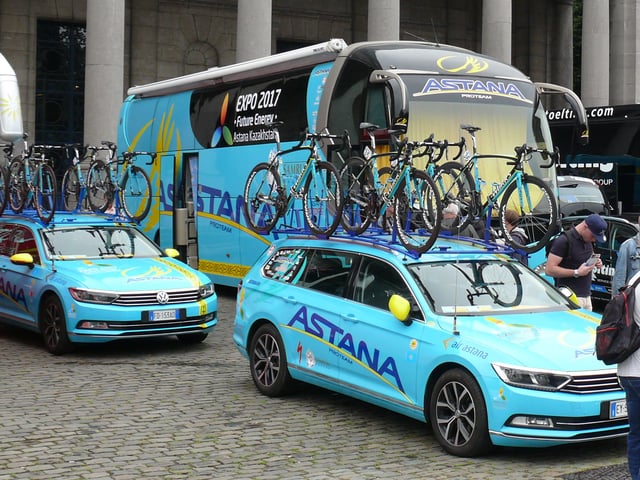
Astana Pro Team is professional cycling team representing Kazakhstan and sponsored by the state-owned companies from Kazakhstan
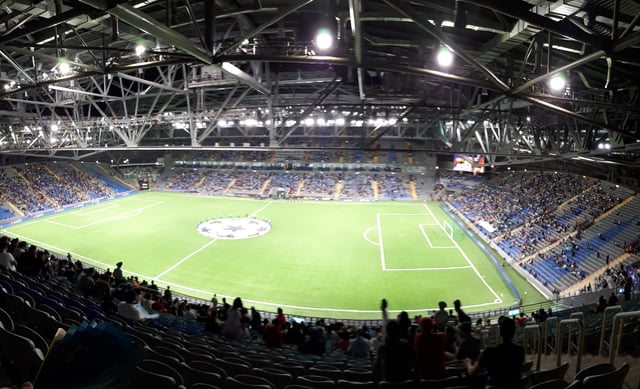
Astana Arena opened in 2009
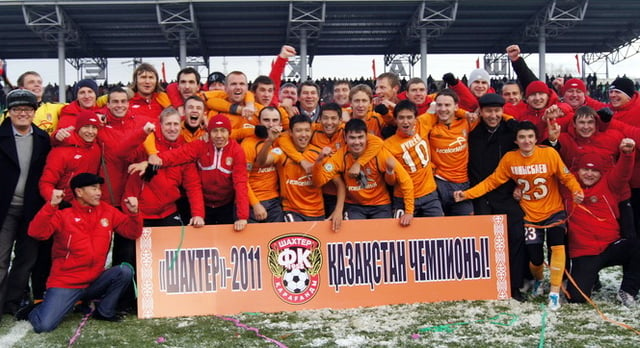
FC Shakhter Karagandy players

Barys Arena in 2015

Nikolai Antropov.
Kazakhstan consistently performs in Olympic competitions. It is especially successful in boxing. This has brought some attention to the Central Asian nation and increased world awareness of its athletes. Dmitry Karpov and Olga Rypakova are among the most notable Kazakhstani athletics. Dmitry Karpov is a distinguished decathlete, taking bronze in both the 2004 Summer Olympics, and the 2003 and 2007 World Athletics Championships. Olga Rypakova is an athlete, specialized in triple jump (women's), taking silver in the 2011 World Championships in Athletics and Gold in the 2012 Summer Olympics.
Kazakhstan's city of Almaty submitted twice bid for the Winter Olympics: in 2014 and again for the 2022 Winter Olympics. Nur-Sultan and Almaty hosted the 2011 Asian Winter Games.[218]
Popular sports in Kazakhstan include football, basketball, ice hockey, bandy, and boxing.
Football is the most popular sport in Kazakhstan. The Football Federation of Kazakhstan is the sport's national governing body. The FFK organises the men's, women's, and futsal national teams.
Kazakhstan's most famous basketball player was Alzhan Zharmukhamedov, who played for CSKA Moscow and the Soviet Union's national basketball team in the 1960s and 1970s. Throughout his career, he won multiple titles and medals at some of the world's most prestigious basketball competitions, including the Summer Olympics, the Basketball World Cup, the EuroBasket (the European Basketball Championship), and the EuroLeague. In 1971 he earned the title Master of Sports of the USSR, International Class and a year later he was awarded the Order of the Badge of Honor.Kazakhstan's national basketball team was established in 1992, after the dissolution of the Soviet Union. Since its foundation, it has been competitive at the continental level. Its greatest accomplishment was at the 2002 Asian Games, where it defeated the Philippines in its last game to win the bronze medal. At the official Asian Basketball Championship, now called FIBA Asia Cup, the Kazakhs' best finish was 4th place in 2007.
The Kazakhstan national bandy team is among the best in the world, and has many times won the bronze medal at the Bandy World Championship, including the 2012 edition when Kazakhstan hosted the tournament on home ice.[219][220] In the 2011 tournament, they were an extra-time in the semi-final from reaching the final for the first time. In 2012, they were even closer when they took it to a penalty shootout. The team won the first bandy tournament at the Asian Winter Games. During the Soviet time, Dynamo Alma-Ata won the Soviet Union national championships in 1977 and 1990 and the European Cup in 1978. Bandy is developed in 10 of the country's 17 administrative divisions (8 of the 14 regions and 2 of the 3 cities which are situated inside of but are not part of regions).[221] Akzhaiyk from Oral, however, is the only professional club.
The Kazakh national ice hockey team have competed in ice hockey in the 1998 and 2006 Winter Olympics, as well as in the 2006 Men's World Ice Hockey Championships. The Kazakhstan Hockey Championship is held since 1992. Barys Astana is the main domestic Kazakhstani ice hockey professional team, and having played in the Kazakhstani national league until the 2008–09 season, when they were transferred to play in the Kontinental Hockey League. Meanwhile, the Kazzinc-Torpedo and play in the Supreme Hockey League since 1996 and the Saryarka Karagandy since 2012. Top Kazakhstani ice hockey players include Nik Antropov, Ivan Kulshov and Evgeni Nabokov.
Kazakh boxers are generally well known in the world. In the last three Olympic Games, their performance was assessed as one of the best and they had more medals than any country in the world, except Cuba and Russia (in all three games). In 1996 and 2004, three Kazakhstani boxers (Vassiliy Jirov in 1996, Bakhtiyar Artayev in 2004 and Serik Sapiyev in 2012) were recognized as the best boxers for their techniques with the Val Barker Trophy, awarded to the best boxer of the tournament. In boxing, Kazakhstan performed well in the 2000 Summer Olympics in Sydney, Australia. Two boxers, Bekzat Sattarkhanov and Yermakhan Ibraimov, earned gold medals. Another two boxers, Bulat Zhumadilov and Mukhtarkhan Dildabekov, earned silver medals. It should also be noted that Oleg Maskaev, born in Zhambyl, representing Russia, was the WBC Heavyweight Champion after knocking out Hasim Rahman on 12 August 2006. The reigning WBA, WBC, IBF and IBO middleweight champion is Kazakh boxer Gennady Golovkin. Natascha Ragosina, representing Russia, but from Karaganda held seven versions of the women's super middleweight title, and two heavyweight titles during her boxing career. She holds the record as the longest-reigning WBA female super middleweight champion, and the longest-reigning WBC female super middleweight champion.
Film
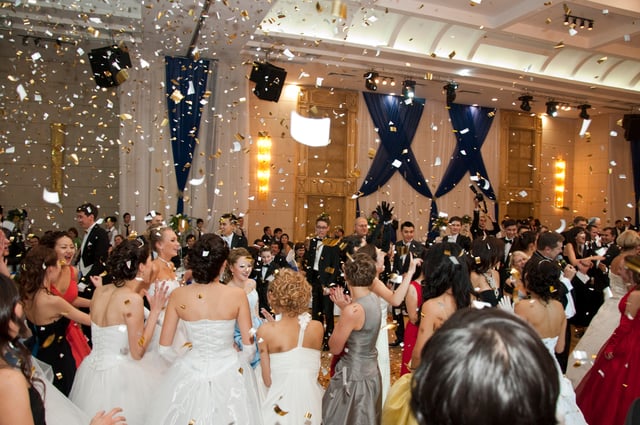
A charity ball in Almaty
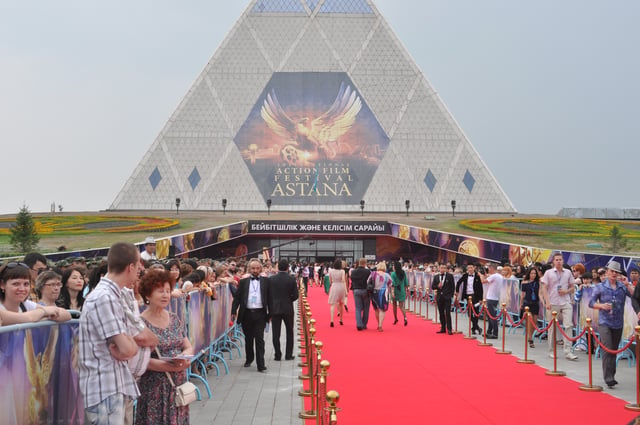
International Astana Action Film Festival, 2010.
Kazakhstan's film industry is run through the state-owned Kazakhfilm studios based in Almaty. The studio has produced award-winning movies such as Myn Bala, Harmony Lessons, and Shal. Kazakhstan is host of the International Astana Action Film Festival and the Eurasia International Film Festival held annually. Hollywood director Timur Bekmambetov is from Kazakhstan and has become active in bridging Hollywood to the Kazakhstan film industry.
Serik Aprymov's Little Brother (Bauyr) won at the Central and Eastern Europe Film Festival goEast from the German Federal Foreign Office.[224]
Media

Timur Bekmambetov, a notable Kazakh director.
Kazakhstan is ranked 161 out of 180 countries on the World Press Freedom Index, compiled by Reporters Without Borders.[225] A mid-March 2002 court order, with the government as a plaintiff, stated that Respublika were to stop printing for three months.[226] The order was evaded by printing under other titles, such as Not That Respublika.[226] In early 2014, a court also issued a cease publication order to the small-circulation Assandi-Times newspaper, saying it was a part of the Respublika group. Human Rights Watch said: "this absurd case displays the lengths to which Kazakh authorities are willing to go to bully critical media into silence."[227]
With support from the US Department of State's Bureau for Democracy, Human Rights and Labor (DRL), the American Bar Association Rule of Law Initiative opened a media support centre in Almaty to bolster free expression and journalistic rights in Kazakhstan.[228]
UNESCO World Heritage sites
Kazakhstan has three cultural and natural heritages on the UNESCO World Heritage list: the Mausoleum of Khoja Ahmed Yassaui, Petroglyphs within the Archaeological Landscape of Tamgaly, and the Korgalzhyn and Nauryzumsky reserves.[229]
Public holidays
Membership of international organisations
Kazakhstan's membership of international organisations includes:
Shanghai Cooperation Organisation
Euro-Atlantic Partnership Council
Individual Partnership Action Plan, with NATO, Ukraine, Georgia, Azerbaijan, Armenia, Moldova, Bosnia and Herzegovina and Montenegro.
Turkic Council and the TÜRKSOY community. (The national language, Kazakh, is related to the other Turkic languages, with which it shares cultural and historical ties.)
Organization for Security and Co-operation in Europe (OSCE)
UNESCO, where Kazakhstan is a member of its World Heritage Committee.[230]
Nuclear Suppliers Group as a participating government.
Organization of Islamic Cooperation[232]
See also
Outline of Kazakhstan
Index of Kazakhstan-related articles

